Don't wanna be here? Send us removal request.
Text
Castlevania: Lords of Shadow Series Review - The Final Chapter of Castlevania
Introduction: The Dawn of Fate and a Series Reimagined
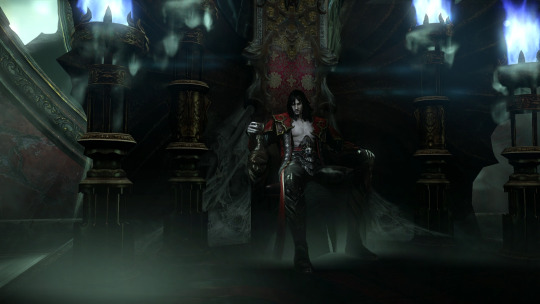
My first encounter with the Castlevania series dates back 24 years, to Castlevania: Circle of the Moon. It was my very first Castlevania game, and my introduction to the Metroidvania genre. From that moment, I fell in love with this unique blend of ability progression and exploration, all set within a dark, gothic ancient castle. I completed all three Castlevania titles on the GBA, striving for 100% completion whenever possible. Later, I delved into Castlevania: Symphony of the Night via a PC emulator. Even in 2025, this game's art style, character design, map size, and monster designs still surpass 90% of the Metroidvania-tag games on Steam. It's a shame that Konami's Castlevania PC collection doesn't include it. I highly recommend that any Metroidvania fan give Symphony of the Night a try; it's a testament to how classic games can truly stand the test of time.
As the gaming industry entered the 3D era, the Castlevania series, renowned for its 2D side-scrolling gameplay, faced an inevitable transformation. Konami had previously released several 3D Castlevania games, but none garnered player approval or commercial success. Convinced that the series needed a radical overhaul to appeal to Western markets, Konami decided to outsource the new Castlevania title to a Western game studio. They found MercurySteam, the developers behind the surprisingly impressive horror FPS, Clive Barker's Jericho.
Initially, MercurySteam didn't pitch a Castlevania game to Konami. Instead, they proposed an entirely new IP called "Highlander." Konami was impressed by the project's potential and quality, believing its dark fantasy aesthetic and fluid action design resonated with the essence of Castlevania. At the time, Konami was hesitant about how to handle the important Castlevania IP. It was David Cox (a producer at Konami Europe, who was a key driving force behind the Lords of Shadow series) who showcased MercurySteam's early work to Konami's Japanese executives. Legendary game creator Hideo Kojima saw the project's potential and proactively offered his assistance.
With Kojima's endorsement and involvement, Konami ultimately decided to transform MercurySteam's original project into a complete reboot of the Castlevania series: Castlevania: Lords of Shadow. This decision meant the game would entirely break away from the original Belmont family lore and timeline, telling a brand new story. This unexpected transformation proved to be a massive success, with Castlevania: Lords of Shadow selling 1.75 million copies, making it the best-selling title in Castlevania history. Encouraged by this, Konami commissioned MercurySteam to develop two sequels: Castlevania: Lords of Shadow – Mirror of Fate and Castlevania: Lords of Shadow 2. Unfortunately, neither of these sequels met Konami's sales or critical expectations, leading to the unfortunate end of major new entries in the renowned Castlevania series. Today, let's take a look back at the Castlevania: Lords of Shadow series – the "final chapter" of Castlevania.
Castlevania: Lords of Shadow: God of War Gameplay Meets Dark Gothic Art
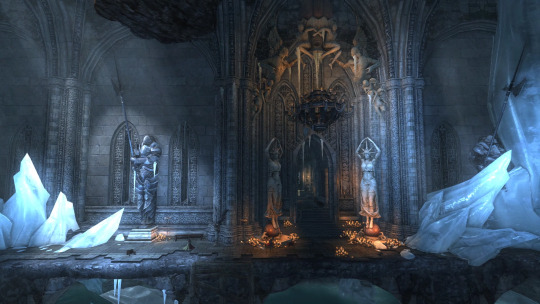
Game Development Background: Series Reboot and 3D Transition
The development period for Castlevania: Lords of Shadow (roughly 2007-2010) was a pivotal era for the seventh generation of consoles (Xbox 360, PlayStation 3, and Wii). During that time, once-dominant 2D games were becoming niche, while now-famous titles like God of War, Devil May Cry, Assassin's Creed, and Mass Effect were making their debut. Japanese game developers' exquisite 2D art no longer held the same prominence in this new age, and their often clunky and outdated 3D game presentations struggled against Western counterparts. It was during this period that Konami began outsourcing new entries for its renowned IPs like Castlevania and Silent Hill to Western game studios, aiming to combine Western game development techniques with Japanese creative understanding to craft AAA titles suitable for the Western market.
Castlevania: Lords of Shadow didn't use a popular third-party engine like Unreal Engine 3. Instead, MercurySteam developed its own "Mercury Engine" specifically for the game. This proprietary engine showcased impressive visual fidelity, easily matching or even surpassing Unreal Engine 3. Given the previous 3D Castlevania games' failures in both critical reception and sales, producer David Cox emphasized that unlike those attempts to shoehorn 2D gameplay into 3D, Castlevania: Lords of Shadow was designed from the ground up as a 3D action game. This meant the core mechanics, level design, and combat system were tailor-made for a 3D environment, rather than simply replicating 2D jumping and platforming elements.
In terms of gameplay, Castlevania: Lords of Shadow clearly drew inspiration from popular 3D action-adventure games of the time, especially Sony's God of War series and Capcom's Devil May Cry series. It featured a fixed camera perspective, QTEs (Quick Time Events), epic boss battles, and a combat system emphasizing whip-based combos, delivering a strong God of War-esque adventure and combat experience. Despite its significant departure from traditional 2D Castlevania gameplay, the game diligently preserved the series' classic dark gothic horror aesthetic in its art style. The vast, eerie castles, unique monster designs, and grand musical scores all strived to create an authentic Castlevania atmosphere. This approach proved successful: even though it abandoned Castlevania's traditional 2D Metroidvania gameplay, Castlevania: Lords of Shadow resonated with mainstream players of the time, becoming the best-selling title in the Castlevania series.
3D Platforming: Climbing, Swinging, and Jumping
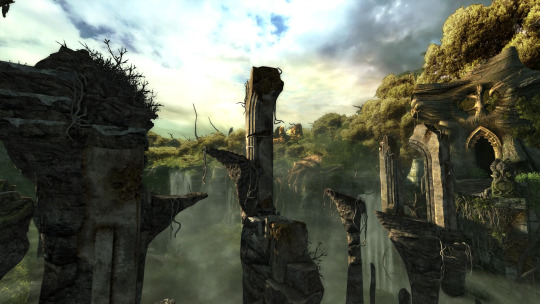
Just like typical 3D action-adventure games of that era, such as Prince of Persia and God of War, players often had to scale cliffs, leap across chasms, or swing between various points like Tarzan. Many times, players also faced harsh environmental hazards, like crumbling cliffs, traps spewing fire or electricity, or rapidly rising lava. Players needed to quickly complete climbing, jumping, and swinging actions within limited timeframes. These 3D platforming sections made up about a quarter of the game's levels.
3D Combat: The Combat Cross and Epic Boss Fights
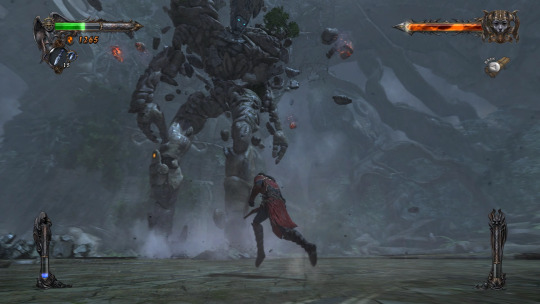
This game clearly had a strong God of War vibe. Players primarily used a weapon called the "Combat Cross," which was a whip. While the main weapon in Castlevania has always been a whip, unlike the linear horizontal attacks in 2D Castlevania games, the Combat Cross's attack styles and moves in Castlevania: Lords of Shadow felt more akin to God of War's Blades of Chaos. The combat's impact and feel also strongly resembled classic God of War. By the way, Lords of Shadow 2's combat style was more like Devil May Cry.
In the game, players faced three monumental Titan Boss battles. These encounters clearly drew inspiration from Shadow of the Colossus, requiring players to climb the immense bosses and attack their weak points, like their heads. Besides the Titans, players also fought various other bosses such as a Raven Witch, Lycan, Vampire, Dark Knight, and Satan. Each boss had its own unique combat style and specific mechanics for defeating them. For example, to beat the Lycan boss, you had to destroy pillars in the arena, while defeating Satan required cleverly switching between Light and Shadow Magic. Coupled with the medieval hymn-style background music, these boss battles delivered a powerful, epic feeling. While they might not have reached the same breathtaking heights as Shadow of the Colossus, they were still excellent for a game released in 2010.
3D Puzzles: Item Collection and Mini-Games
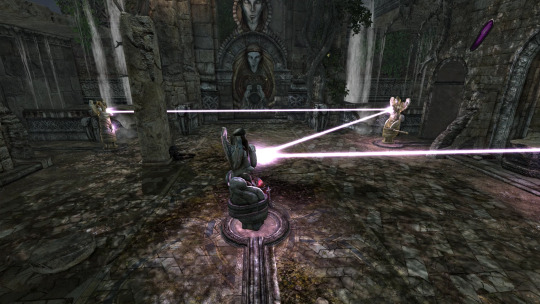
Like Resident Evil and God of War, this game featured several puzzle-oriented levels. Players needed to freely explore the level to find key puzzle items, place them in the correct spots, and then play mini-games to solve the puzzles. This was a common element in action-adventure games of that era, but it's relatively less common in current-generation titles. Some of the puzzles in this game were decently designed, but personally, I found most of them a bit boring. As with other typical action-adventure games, the levels contained numerous collectibles, such as Life Gems (which increase maximum health) or Knight Diaries (which expand on the game's lore). However, the game lacked truly unique items to further incentivize exploration.
Art & Music: Dark Gothic Aesthetics and Religious Hymn OST
The most memorable aspects of Castlevania: Lords of Shadow are undoubtedly its art style and background music. The game adopted the classic dark gothic aesthetic of the Castlevania series, blended with the grand-scale environments reminiscent of God of War and Shadow of the Colossus. Early levels featured numerous ruins, evoking the feeling of Angkor Wat but with their own distinct and consistent ancient civilization art style. The vampire castle levels in the latter half of the game were a 3D rendition of classic 2D Castlevania settings – opulent castles, intricate reliefs, delicate chandeliers, and even preternaturally advanced electrical technology. The game's background music, with its ethereal female vocals, resembled medieval Catholic hymns. Whenever I heard these sacred melodies, I felt as if I were a knight of God, bravely confronting evil.
Narrative and World-Building: A Reimagining of the Castlevania Lore and Dracula's Origin
This game didn't simply inherit the Castlevania series' established lore and timeline. Instead, it ingeniously utilized classic Castlevania elements to construct an entirely new world. This reimagined universe begins in medieval Europe and introduces an organization previously unseen in the series: the Brotherhood of Light, with protagonist Gabriel Belmont as one of its members. This marked the first significant expansion of the Castlevania series' world, shifting the narrative beyond the millennium-long conflict between the Belmonts and Dracula to encompass a grand expedition by the Brotherhood of Light knights against the forces of darkness. The collectible "Knight Diaries" within the game recounted the stories of various Brotherhood of Light knights. These narrative elements ensured Lords of Shadow's world was cohesive and logically consistent, possessing substantial potential for future plot extensions.
Overall Impression
Castlevania: Lords of Shadow is essentially a new action-adventure game that borrows some elements from the Castlevania series, rather than being a direct sequel to the 2D Castlevania games. As a 2010 title, its excellent dark gothic art direction and religiously-inspired background music ensure it doesn't feel dated even in 2025. Its God of War-like gameplay, compared to traditional 2D Castlevania, resonated more with mainstream players of the time. The only regret about the first Lords of Shadow game is that it didn't retain the Metroidvania gameplay.
Pros:
Gorgeous dark fantasy medieval gothic art style
Hybrid gameplay mechanics blending various genres
Numerous unique and varied level environments and monsters
Cons:
Tedious and easily failed QTEs
Challenging and unforgiving trap sections
Castlevania: Lords of Shadow – Mirror of Fate: 2.5D Metroidvania and Missing RPG Elements
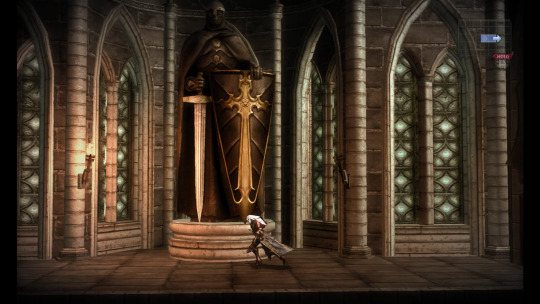
Game Development Background: The Return of Metroidvania and 3DS Adaptation
After Castlevania: Lords of Shadow achieved the highest sales in Castlevania history, Konami continued to entrust MercurySteam with developing a sequel. Given that many of the popular Metroidvania entries in the Castlevania series were primarily on Nintendo handhelds like the GBA and NDS, Konami decided to launch a Metroidvania-style Castlevania: Lords of Shadow sequel on the Nintendo 3DS. This also marked MercurySteam's first foray into 3DS development, laying the groundwork for their future work on two Metroid games.
For Mirror of Fate, MercurySteam continued to use the "Mercury Engine" from the previous game, adapting it specifically for the 3DS platform. Producer Enric Alvarez noted that porting the engine to the 3DS was a "considerable challenge," as the 3DS is a "very special, very powerful" platform with both stereoscopic display and dual cameras. He even stated that they almost "built an engine from scratch for the 3DS," which clearly indicates the immense effort they put into ensuring performance and visual fidelity on the handheld.
As a 3DS exclusive, the game fully leveraged the 3DS's glasses-free 3D functionality, using depth of field effects to enhance the sense of space and visual impact of the environments. The producer once mentioned that the 3DS's stereoscopic display was perfect for "layered" 3D effects, making the 2.5D environment feel more vibrant. MercurySteam explicitly stated in news reports that the choice of 2.5D was a tribute to classic 2D Castlevania games. Mirror of Fate offered some Metroidvania-style exploration and platforming. Despite the camera shift, Mirror of Fate's combat system largely inherited the core of Lords of Shadow 1, including whip combos, blocking, dodging, light and dark magic, and sub-weapons. This made the combat experience feel deeper and more action-oriented than traditional 2D Castlevania. Game producer David Cox said, "We wanted to integrate more classic exploration elements and combine them with a more modern, combat-focused approach."
2.5D Metroidvania: Multi-Character Linear Maps and Missing Classic Castlevania RPG Elements
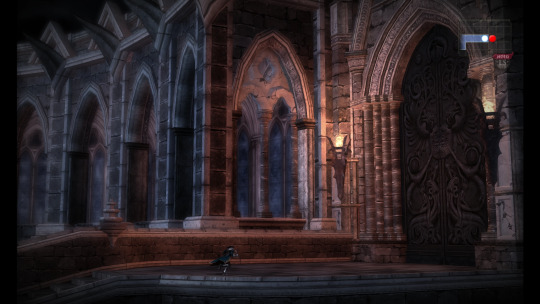
The gameplay experience of Mirror of Fate is similar to most 2D Metroidvania games: players explore various areas within a vampire castle, engaging in platforming, solving puzzles, navigating traps, acquiring key items, reaching hidden areas, and battling dark creatures and bosses. However, unlike typical 2D Metroidvania titles, Mirror of Fate allows players to assume the roles of three different characters, each with their own special abilities and corresponding unique maps. Furthermore, the map environments and monsters encountered by each character differ, which is a major distinction from other 2D Metroidvania games.
Nevertheless, as a successor to 2D Castlevania, while Mirror of Fate incorporates 2D Metroidvania exploration elements, its map exploration experience feels relatively linear. Players must advance through areas in a predetermined order, lacking the freedom to choose which region to explore first. More disappointingly, this title lacks the RPG elements found in Castlevania games on the GBA and NDS, such as equipment customization or direct character stat increases through leveling. This results in less gameplay depth compared to traditional 2D Castlevania. It's truly regrettable that the last 2D Castlevania game lacks RPG elements.
2D Platforming Action & Combat: Inherited and Improved Lords of Shadow Combat with Underwhelming Boss Battles
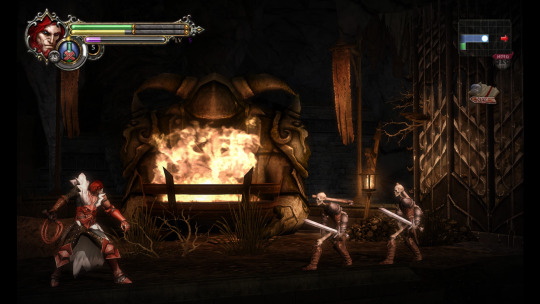
The combat in Mirror of Fate inherited the fighting style of its predecessor, Lords of Shadow, adapting it for a 2D platforming environment. Players continued to use the whip as their primary weapon, with most of the moves from the first game carried over and simplified in terms of button inputs. The game's sense of impact, evident in enemy hit reactions and force feedback, was significantly improved, making it one of the better combat experiences in 2D Metroidvania games.
However, Mirror of Fate featured a limited number of bosses, and each boss's attack patterns were fixed and repetitive, with lackluster combat animations. The uninspired boss battles squandered the game's otherwise excellent combat feel and its unique God of War-like combat experience within a 2D Metroidvania framework.
Art & Music: Simplistic 3D Models, Lacking Environmental Detail, and Stunning Comic Book Cutscenes
Likely due to the 3DS's hardware limitations, the character and monster models in Mirror of Fate during actual gameplay felt quite simplistic. The intricate environmental details of Castlevania's iconic dark gothic art style were also notably absent. Had it not been for the 3DS's glasses-free 3D effect, I believe the game might have benefited more from exquisite 2D graphics.
In stark contrast to the simplistic in-game models, Mirror of Fate utilized comic book-style cutscenes for its narrative. While the story sequences were infrequent, each one was meticulously crafted and left a lasting impression on me.
Narrative and World-Building: The Crucial Link Between Lords of Shadow 1 and 2
The narrative of Mirror of Fate reimagines the very "origin point" of the Castlevania series – the story of Simon battling Dracula in the first Castlevania game. It recontextualizes the classic Castlevania protagonists Simon and Alucard: Dracula is established as the progenitor of the Belmont family, and Simon is his grandson. This family relationship subverts the traditional Castlevania lore of the Belmont clan's millennium-long conflict with Dracula, transforming it into a fated confrontation between Dracula and his own descendants. I can't definitively say whether this new character dynamic is superior to the traditional Castlevania series, but this particular setup firmly establishes the Lords of Shadow series as a complete parallel universe to the traditional Castlevania narrative.
Mirror of Fate served as a critical narrative bridge between Lords of Shadow 1 and 2. It introduced the character of Alucard and the pivotal item, the "Mirror of Fate," preventing a jarring jump in the narrative to the modern era in Lords of Shadow 2. As I mentioned in my previous review of Mirror of Fate, the game seamlessly incorporated many elements from both Lords of Shadow 1 and 2, such as the Combat Cross and Light Magic from the first game, and the Void Sword and Toy Maker concepts from the second.
Overall Impression:
Mirror of Fate is a Metroidvania game that returned to the traditional roots of the Castlevania series, bringing back classic vampire castles and iconic Castlevania monsters. However, compared to the classic 2D Castlevania games on GBA and NDS, this title featured a smaller map with less exploration potential, and crucially, it lacked RPG elements. As MercurySteam's first foray into 2.5D Metroidvania, the game performed decently. Unfortunately, Konami did not commission MercurySteam to develop a sequel to Mirror of Fate, making this 2.5D Castlevania the last Castlevania game with 2D Metroidvania gameplay, thereby failing to continue the series' classic legacy.
Pros:
Return of classic Castlevania series environments and monsters
Relatively good combat experience and hit feedback for a Metroidvania game
Varied level environments and monsters (though some were simplistic)
Impressive comic book-style cutscenes
Cons:
Small map size, limited exploration space
Lacks the iconic RPG mechanics of 2D Castlevania series
Simplistic visuals and lacking environmental detail
Boss attack patterns are repetitive and lack challenge
Castlevania: Lords of Shadow 2: 3D Metroidvania, Abrupt Modern Setting, and Frustrating Stealth
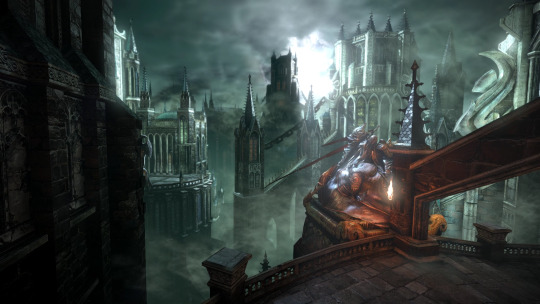
Game Development Background: Konami's Ambition, Kojima's Absence, and Puzzling Development Decisions
Castlevania: Lords of Shadow 2 (hereafter LoS2), unveiled alongside Mirror of Fate at E3 2012, immediately captured the attention of Castlevania fans. Konami, in particular, harbored great ambitions for this title, as the previous game's sales offered hope for revitalizing the Castlevania series.
However, what should have been a new milestone for the Castlevania series instead faced continuous challenges and setbacks during development. Firstly, the game transitioned from the linear levels of its predecessor to a 3D Metroidvania sandbox map that allowed for free exploration. This presented an enormous challenge for the MercurySteam team and their "Mercury Engine." With resources also being pulled to simultaneously develop Mirror of Fate, the MercurySteam team was forced to complete a project far more complex than its predecessor within a limited timeframe and with insufficient personnel. This led to online rumors of MercurySteam employees suffering from crunch time and mismanagement issues.
Adding to the woes, Hideo Kojima, who had provided guidance and support for the previous game, was by then largely focused on Metal Gear Solid V: The Phantom Pain. Consequently, he reportedly had minimal involvement in LoS2's development, which may have contributed to the final product's perceived lack of cohesion.
Beyond the significant development hurdles, LoS2's game development decisions also caused unease among Castlevania fans: the game's setting abruptly shifted from the medieval period of Lords of Shadow and Mirror of Fate to a modern-day backdrop, a complete departure from the series' historical medieval castle settings. Furthermore, the stealth gameplay shown in trailers felt out of place with the Castlevania series' traditional combat, and the notion of a powerful Dracula having to hide from modern soldiers seemed inconsistent with his established role as the ultimate boss in the series.
Producer David Cox and Game Director Enric Alvarez (co-founder and CEO of MercurySteam) addressed these decisions in multiple interviews and developer diaries leading up to the game's release:
Regarding the Modern Setting: David Cox and Enric Alvarez repeatedly emphasized that setting Lords of Shadow 2 in the modern era was to fulfill the cliffhanger left at the end of Lords of Shadow 1. In the post-credits scene of the first game, Dracula awakens in a modern city to face the return of Satan. Thus, the modern setting was the "destiny" of the entire trilogy's narrative arc and Dracula's ultimate path to redemption. Enric Alvarez mentioned in interviews that the design of the modern city aimed to convey the vastness of the world to players while offering vertical exploration and environmental interaction different from the castle. This design philosophy, where "the city itself is an extension of the castle," allowed modern elements and gothic aesthetics to coexist.
Regarding Stealth Gameplay: David Cox and Enric Alvarez frequently stated that Dracula was not at his peak strength at the beginning of the game; he was extremely weakened after his long slumber. Early in the story, he needed to gradually regain his power. Therefore, when facing certain overwhelming enemies, he couldn't confront them head-on and had to resort to stealth to avoid risks or find weaknesses. They hoped this approach would allow players to experience Dracula's "vulnerable side" and increase the game's tension. They also aimed to introduce stealth to break up the rhythm of pure hack-and-slash combat, offering players a different gameplay experience and preventing combat fatigue. David Cox stated in an interview that they wanted the game to have "more activities to intersperse among the bloodiness" and aimed to offer a more diverse experience.
3D Metroidvania: Story-Driven Linear Levels and "Dessert" Exploration
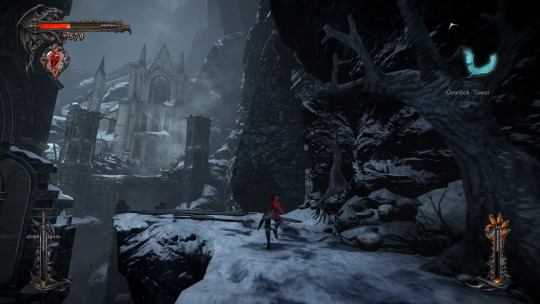
Similar to its predecessor, Lords of Shadow, the main campaign of this game remained a story-driven linear action-adventure. Players were typically guided by the narrative, moving to objective locations, defeating level bosses, unlocking new abilities, and then being teleported to new areas to continue the adventure.
However, after completing the main story, players could return to previously visited locations for free exploration, using newly acquired abilities to reach hidden areas inaccessible during the main campaign. As players explored, they would discover that the two large maps in the game were interconnected—players could travel from an exit in one area to another, consistent with typical Metroidvania region structures. This game demonstrated MercurySteam's capability in designing a classic Metroidvania map. Unfortunately, in this last major Castlevania production, the Metroidvania elements served merely as a "dessert" rather than the primary gameplay, which is truly regrettable.
3D Combat: Improved Experience and Frustrating Enemy Design
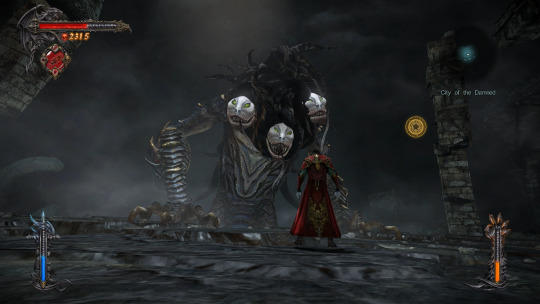
This game inherited the God of War-like combat mechanics from its predecessor, Lords of Shadow, and significantly improved the combat experience. The number of weapons increased from one to three, and combat became smoother and faster, with the overall feel leaning closer to Devil May Cry. The sense of impact and hit feedback when striking enemies were also notably enhanced; most enemies now had clear hit animations and controller vibration feedback, and the hit sound effects and vibration intensity varied distinctly with different weapons. Furthermore, the frustrating QTEs (Quick Time Events) from the previous game were drastically reduced, appearing only at critical moments with more lenient timing requirements.
However, in contrast to the improved combat experience, the design of some new enemy types in this game was quite poor, leading to frustration:
Shielded/Heavily Armored Enemies: These enemies couldn't be damaged directly from the front. Players needed to use the specific weapon "Chaos Claws" to continuously attack and break their shields or armor, which consumed mana.
Monk-type Enemies: As long as they remained on the battlefield, they would continuously summon new enemies. If players couldn't quickly eliminate these enemies, they would be forced to repeatedly fight endlessly spawning weaker foes.
Infinitely Resurrecting Bloody Skeletons: After defeating these enemies, they would transform into a puddle of flowing blood and resurrect as new skeletons within seconds. Players had to continuously attack the blood puddle during this brief window to prevent resurrection. However, this window was extremely short and easily interrupted by enemy attacks, often forcing me to repeatedly attack the same enemy.
Compounding these issues, the enemies in this game had overly aggressive attack patterns, and even basic enemy attacks could interrupt the protagonist's attacks, easily breaking the flow of combat and causing frustration.
3D Climbing and Jumping: Restricted Assassin's Creed-Style Experience
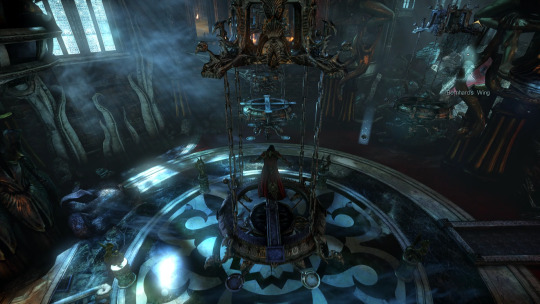
This game featured many climbing and jumping sections, requiring players to continuously ascend and leap between walls, ladders, and pillars, sometimes needing double jumps to reach distant platforms. The climbing and jumping experience felt more akin to Assassin's Creed 1-3. However, unlike Assassin's Creed, where players could climb almost any wall, in this game, only specific areas of the environment allowed for climbing, which limited the freedom of exploration.
Stealth & Evasion: Simplistic Mechanics and Single "Correct Answer"
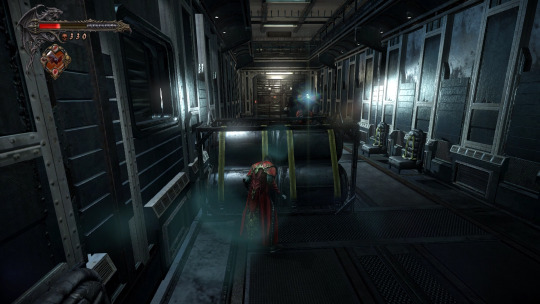
The main story of this game featured several mandatory stealth sections. In these segments, players couldn't attack enemies and would die within seconds if detected. Players had to use bats to distract enemies, transform into rats to pass through narrow passages, and finally sneak behind enemies to possess them, then control their bodies to activate gate switches.
Compared to other classic stealth games, this game's stealth levels felt constrained with narrow spaces and a lack of effective means for players to deal with patrolling enemies. Consequently, there was often only a single "correct answer" for navigating these stealth sections: players had to follow a specific route to pass, lacking the freedom found in other stealth titles. I found the stealth sections to be the worst part of this game.
Art & Music: Gorgeous Gothic Castle vs. Abrupt Modern City
This game featured two main maps: one was Dracula's Castle, reminiscent of the vampire castle from the previous game, inheriting Castlevania's classic dark gothic art style; the other was a retro-futuristic modern city akin to Arkham City from Batman: Arkham City. The castle section offered an excellent art experience; even 11 years later, it remains one of the most exquisite vampire castle environments in vampire-themed games. However, the modern city portion felt completely out of place with Castlevania's style. Switching between the two maps created a severe sense of disconnect, breaking the game's intended immersion.
The game's background music continued the religious hymn style and epic scope of its predecessor. Paired with Dracula's journey of self-redemption, it created a strong sense of immersion while adventuring in the castle sections, like watching an epic story unfold.
Narrative and World-Building: Dracula's Self-Redemption and a Muddled Modern Plot
Lords of Shadow 2's story takes place a millennium after the first Lords of Shadow, with the setting abruptly shifting from medieval times to the modern era. The plot is divided into two distinct parts:
Dracula regaining his lost power and recovering his memories within his illusory Dracula's Castle, ultimately achieving self-redemption. (This part has many connections to Lords of Shadow and Mirror of Fate, making the trilogy's plot complete.)
Dracula searching for three of Satan's acolytes in the modern city to prevent Satan's return. However, this modern-day plot segment was convoluted and illogical; I previously analyzed in detail how poor its narrative was in my review of Lords of Shadow 2.
Consequently, the two disconnected parts, especially the problematic modern city storyline, led to Lords of Shadow 2 receiving poor reviews, despite being intended as the trilogy's satisfying conclusion. This also resulted in the Castlevania series having no major new entries since.
Overall Impression
Castlevania: Lords of Shadow 2 should have continued the story of Castlevania: Lords of Shadow, further exploring medieval adventures. However, MercurySteam's team aggressively shifted the story to a modern setting and introduced stealth sections that were inconsistent with the series' traditions. Despite featuring smoother combat and explorable 3D Metroidvania levels compared to its predecessor, which could have been the starting point for Castlevania's revitalization, it unfortunately became the final major game of the Castlevania series.
Pros:
Return of Castlevania series' Metroidvania exploration, presented in a 3D open-world style
Excellent combat experience and hit feedback
Gorgeous dark gothic art style and detailed environments
Cons:
Stylistic disconnect between the vampire castle and modern city maps
Tedious and forced stealth elements
Mecha-style enemies that clash with the overall aesthetic
Abrupt and illogical plot
1 note
·
View note
Text
60S Quick Look Good Game: Castlevania: Lords of Shadow – Mirror of Fate
0 notes
Text
A Disappointing Early Foray into 3D Metroidvania - Castlevania: Lords of Shadow 2
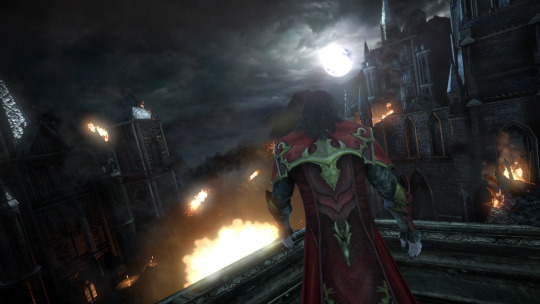
1. Introduction
Game Title: Castlevania: Lords of Shadow 2
Release Date: Feb 26, 2014 (PC)
Genre: 3D Metroidvania, Action-adventure, Hack and Slash
Playtime: 15-30 hours
Overview:
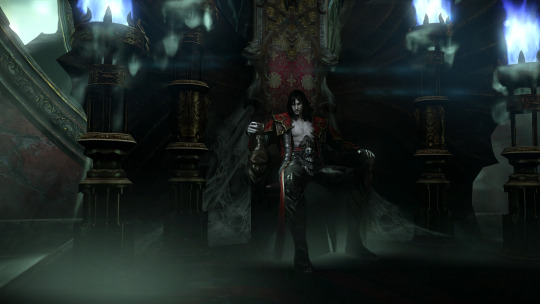
Castlevania: Lords of Shadow 2 marks the conclusion of the Lords of Shadow saga and, regrettably, stands as the last major installment in the Castlevania series to date. Departing from its predecessor, Lords of Shadow 2 builds upon the excellent dark gothic art style and God of War-esque combat of the first game by reintroducing the Metroidvania exploration mechanics that are classic to the Castlevania franchise. Players navigate through the sprawling Vampire Castle and a dark, gothic-infused modern city, gradually unlocking abilities such as bat transformation, mist form, and double jump. These new powers grant access to hidden areas, allowing for encounters with a diverse array of enemies, including vampires, skeleton warriors, demons, cyberpunk soldiers, and cyberpunk mechs, interspersed with a handful of stealth sections.
2. Gameplay Mechanics
Story-Driven 3D Metroidvania Exploration:

This installment cleverly integrates the core mechanics of the classic 2D Metroidvania gameplay – the gradual acquisition of abilities to unlock and explore new areas – into a 3D environment. The game features two expansive maps: Castlevania City and Dracula’s Castle. Each of these is divided into four freely explorable levels, which in turn contain numerous interconnected sub-levels. Scattered throughout these environments are hidden zones accessible only by utilizing newly acquired abilities or solving environmental puzzles, often rewarding players with health upgrades or lore-rich collectibles.
However, unlike typical Metroidvania titles, the main story progression in Lords of Shadow 2 feels more akin to a linear action-adventure game. Players are driven by the narrative, moving from objective to objective, defeating level bosses, unlocking new abilities, and then being transported via the story to new areas for further adventure. This contrasts with the traditional Metroidvania experience of freely exploring a map, encountering initially inaccessible regions, unlocking new abilities in specific areas, and then using these abilities to reach previously unreachable zones.
Consequently, players primarily focused on the main storyline might perceive the game as a linear, level-based action-adventure title. The Metroidvania exploration elements, in this context, feel more like an afterthought. This is where my greatest disappointment lies. Mercury Steam had the potential to deliver a compelling 3D Metroidvania exploration experience, akin to STAR WARS Jedi: Fallen Order™. Had they focused on this, the game could have garnered higher critical acclaim and sales. Mercury Steam possessed the capability to create a flawless 3D Metroidvania exploration game, but they ultimately produced a mixed bag of gameplay modes that diluted its core mechanics.
God of War-Like Hack and Slash:
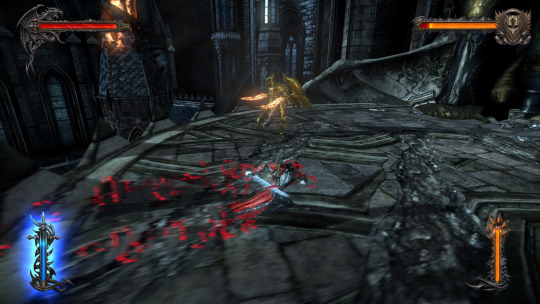
If the combat experience of the original Lords of Shadow resembled early God of War titles, with colossal bosses, QTEs, and the Blades of Chaos-inspired Combat Cross, then Lords of Shadow 2’s combat leans more towards the style of Devil May Cry. The combat tempo is significantly faster, with Dracula capable of continuous, multi-directional high-speed dashes. Players can swiftly switch between three distinct weapon types, each boasting a comprehensive move list, allowing for fluid execution of various moves to dispatch enemies in high-octane, rapid-fire encounters.
The impact and feedback upon striking enemies have been drastically improved compared to the first Lords of Shadow. Most enemies now exhibit clear hit animations and responsive controller vibrations. The impact sounds and vibration intensity vary significantly depending on the weapon used. Furthermore, the often-criticized QTEs from the previous game have been substantially reduced, appearing only at crucial moments with more lenient timing windows.
In Lords of Shadow 2, Dracula wields three primary weapons: the Shadow Whip, the Void Sword, and the Chaos Claws. The Shadow Whip functions similarly to the Combat Cross from the original Lords of Shadow, employing a whip for attacks. The Void Sword allows Dracula to convert damage dealt into health and freeze enemies, while the Chaos Claws are powerful gauntlets capable of shattering the armor and shields of heavily armored foes. The DLC also introduces Alucard as a playable character with a swift, katana-like longsword.
Distinct from both Devil May Cry and God of War, and what I consider a defining feature of the Lords of Shadow series’ combat, is the mana system tied to the Void Sword and Chaos Claws. Each use of these weapons consumes Void Mana or Chaos Mana, respectively. To replenish mana, players must defeat enemies without resorting to executions; upon their demise, these enemies will drop red orbs that can be absorbed by pressing the analog stick. Additionally, the Combat Focus mechanic from the first Lords of Shadow returns, rewarding players with an orb drop for every consecutive hit landed without taking damage.
Secondary weapons make a reappearance, but their utility in combat is noticeably diminished compared to the original Lords of Shadow. I found myself using them more as tools for puzzle-solving rather than combat assistance.
The enemy design in Lords of Shadow 2 introduces three new challenging mechanics compared to Lords of Shadow and Mirror of Fate:
First, the game introduces shielded and heavily armored enemy types. These foes cannot be damaged from the front, requiring players to use the Chaos Claws to break their defenses. If Chaos Mana is depleted, players are forced to flank them, significantly increasing the combat difficulty.
Second, Monk-type enemies are introduced, who continuously summon new adversaries as long as they remain alive on the battlefield. Failing to eliminate these summoners quickly can lead to a rapid depletion of health and mana amidst an endless wave of enemies.
Third, the Bloody Skeleton type enemy can revive indefinitely. Upon defeat, they dissolve into a pool of blood, only to reform into a new skeleton within seconds. Players must continuously attack the blood pool during this brief window to prevent their resurrection.
These three enemy types add a layer of challenge to the combat. However, the endlessly summoning enemies and the perpetually reviving skeletons often led to frustration, dampening my enthusiasm for combat. Encountering heavily armored enemies with zero Chaos Mana proved particularly agonizing, forcing constant attempts to attack from behind. Furthermore, these enemy types frequently respawned randomly during exploration, leading to tedious situations like defeating three Bloody Skeletons only to face another set moments later. This poor enemy generation system detracts significantly from the otherwise solid combat experience.
Climbing and Jumping:

Exploration frequently involves navigating environments by climbing walls, ladders, and pillars, occasionally requiring double jumps to reach distant platforms. The climbing and jumping mechanics feel more akin to Assassin’s Creed 1-3 than Prince of Persia. The removal of environmental traps from the previous game means that platforming sections rarely result in repeated deaths due to unforeseen hazards.
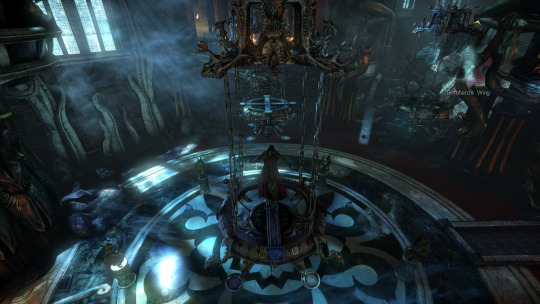
While the item-based puzzle-solving from the first game has been removed, Lords of Shadow 2 introduces numerous intricate climbing sequences. Players must carefully observe their surroundings and strategically plan their climbing and jumping routes to reach their destinations.
Stealth:

Several mandatory stealth sections are woven into the main storyline. In these segments, direct combat is impossible, and detection by enemies results in swift death. Players must utilize bats to distract foes and transform into a rat to traverse narrow passages, ultimately sneaking behind enemies to possess them and use their bodies to activate door switches.
Two of the game’s bosses also require mandatory stealth sequences prior to their boss fights, where players must evade their pursuit and reach a specific location to initiate the battle.
Compared to dedicated stealth games, the stealth mechanics in Lords of Shadow 2 feel uninspired and simplistic, lacking integration with the game’s core gameplay loop. Removing these sections could have potentially enhanced the overall experience.
3. Progression and Collectibles
Move Unlocks and Weapon Mastery:
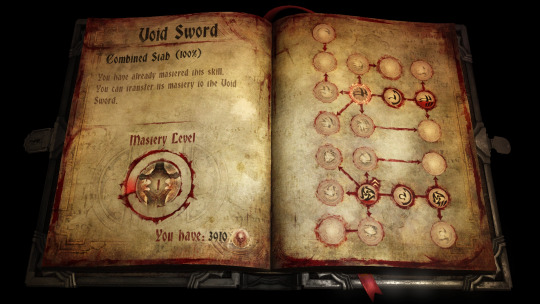
Each of the three main weapons possesses its own distinct and comprehensive move list. Defeating enemies grants experience points, which can be spent to unlock new moves. Repeatedly using the same move in combat accumulates its mastery level. Reaching 100% mastery for a move signifies its complete proficiency. Mastering multiple moves contributes to the weapon’s overall Mastery Level, which can ultimately be raised to level 3.
Health and Mana Capacity Upgrades:
Life Gems, Void Gems, and Chaos Gems are scattered throughout the game’s levels. Collecting five gems of the same type increases the corresponding stat’s maximum capacity. There are 30 gems of each type to be found.
Collectibles and Hidden Content:
Beyond the three types of gems, the game world also contains numerous Knights’ Diaries and City’s Memories, providing players with insights into the game’s lore.
4. Unique Flavors

Lords of Shadow 2 inherits the lavish dark gothic art style prevalent in the Vampire Castle sections of its predecessor, transforming these aesthetics into freely explorable 3D Metroidvania environments. If one were to disregard the game’s other half, the modern city sections, this would be, in my mind, the perfect 3D successor to classic 2D Castlevania titles. Players, much like in Symphony of the Night, embody a vampire protagonist, freely exploring Dracula’s Castle and possessing the ability to transform into a bat or mist.
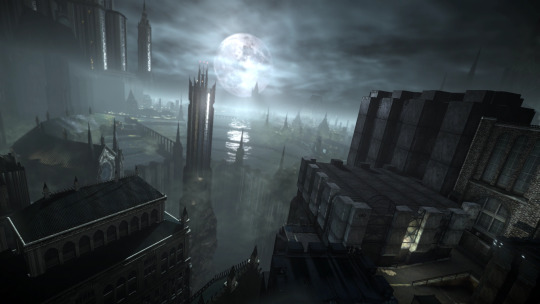
The modern city sections, comprising the other half of the game, also offer a unique flavor. Players explore a metropolis that blends medieval and contemporary architecture. Built upon the ruins of Dracula’s Castle, the city features numerous dark gothic structures, creating an atmosphere reminiscent of Arkham City from Batman: Arkham City. The experience of playing as an ancient vampire battling demons and cyberpunk-style mechs in a futuristic city is, to my knowledge, a unique blend on Steam.
5. Story and Lore
Main Story:
The narrative of Lords of Shadow 2 directly follows the events of Lords of Shadow and Mirror of Fate. The story begins with Dracula’s awakening in the modern city, a direct continuation of the first Lords of Shadow’s ending. Zobek informs Dracula that Satan, defeated in the previous game, is poised for another invasion. To avoid enslavement by Satan, Dracula must seek out three of Satan’s acolytes to prevent his return.
The story unfolds through two interconnected plotlines. The first sees Dracula venturing through the illusory Dracula’s Castle to regain his lost powers and collect the fragments of the Mirror of Fate. The second plotline follows Dracula, guided by Zobek, as he investigates the identities of Satan’s three acolytes and attempts to thwart their schemes in the real-world Castlevania City.
First Plotline: Upon awakening from his slumber, Dracula has lost all his power. Consequently, players repeatedly enter illusions of Dracula’s Castle, formed from Dracula’s memories of the past, to rediscover and reclaim lost abilities such as the Void Sword and Chaos Claws. Within this illusory castle, Dracula encounters Marie, his wife from the first Lords of Shadow, and Trevor, one of the protagonists from Mirror of Fate, appearing as a child. Guided by Marie and Trevor, Dracula recovers his full power and gathers all the fragments of the Mirror of Fate, ultimately confronting and defeating his inner evil, reconciling with his past, and achieving spiritual redemption. I consider this plotline to be the stronger aspect of the game’s narrative, effectively tying together the events of Lords of Shadow and Mirror of Fate.
Second Plotline: Dracula discovers that Satan’s three acolytes have long been lurking within human society, corrupting humanity through demonic influence. Early in the game’s narrative, one of Satan’s acolytes develops a virus capable of transforming humans into demons, which is then unleashed upon the city. Subsequently, the majority of the city’s population transforms into zombie-like demons. The protagonist gradually uncovers the real-world identities of the three Satan’s acolytes, eventually leading to a confrontation with and defeat of Zobek and Satan. I found this plotline to be significantly weaker: “Firstly, the rapid transformation of the entire city into a zombie-infested wasteland reminiscent of Raccoon City in Resident Evil 2, occurring so early in the game, deprives us of seeing Dracula, a centuries-old vampire, confronting the shock of the modern world. Secondly, while the three Satan’s acolytes are given human identities – a pharmaceutical researcher, an arms dealer, and a false priest – the game fails to illustrate how they leverage their societal positions to corrupt humanity. Thirdly, when Dracula captures the pharmaceutical researcher in an attempt to glean information about the first acolyte, she abruptly transforms into the first acolyte without any prior narrative foreshadowing. Fourthly, Dracula’s encounter with the second acolyte sees him rendered helpless by lightning attacks. Despite being portrayed as powerful, this acolyte is defeated once his three possessed statues are destroyed, denying players a direct boss fight against his true form. Fifthly, the third acolyte is narratively built up as being even more powerful than the previous two, yet he is immediately killed by Satan after successfully summoning him, again denying players a boss fight against a seemingly formidable foe. Sixthly, Satan, as the game’s final boss, exerts less presence and threat than even his acolytes. The final boss battle sees him possess Alucard to fight Dracula, and upon Alucard’s defeat, Satan’s true form flees rather than engaging in a decisive battle, only to be killed by Dracula using the Vampire Killer. This ending feels wholly inadequate for a character of Satan’s stature. I had anticipated an epic boss encounter akin to those in the original Lords of Shadow. Furthermore, a significant plot hole arises here: if the Vampire Killer can definitively kill Satan in Lords of Shadow 2, why did Gabriel, wielding the same weapon in the first Lords of Shadow, fail to do so? Moreover, the Vampire Killer is presented as a weapon crafted by humans, so how does it possess the power to permanently kill Satan?”
If the game had solely focused on Dracula’s adventure and self-redemption within Dracula’s Castle, I would have rated the story an 8 out of 10. However, the modern city storyline feels like a poorly executed and incomplete imitation of Resident Evil 2, plagued by illogical and abrupt plot developments.
Character Development and Narrative Depth:
I will evaluate the character development in two parts: the Dracula’s Castle sections and the Castlevania City sections.
Dracula’s Castle Sections:
Dracula’s Castle features the return of several characters from Lords of Shadow and Mirror of Fate, including Marie, Trevor, Alucard, Chupacabra, and the Toy Maker. Deceased characters from the first Lords of Shadow, such as Claudia and the Black Knight, also appear as chess pieces. Carmilla, a boss from the original game, makes a reappearance as a boss in this installment. Agreus, Pan’s brother who aided the protagonist in the first game and ultimately sacrificed himself, also returns as a boss, serving as a poignant reminder of the previous narrative. Across the trilogy, the unwavering support and assistance of Dracula’s wife, Marie, left a lasting impression. Furthermore, Mirror of Fate and Lords of Shadow 2 extensively feature elements related to the Toy Maker – carousels and puppet theaters – with a pre-boss fight puppet show revealing the tragedy of the Toy Maker’s deception and imprisonment within the castle.
Players who have experienced Lords of Shadow, Mirror of Fate, and Lords of Shadow 2 will find that the overarching narrative forms a complete Greek tragedy. Gabriel, a knight of the God’s Brotherhood of Light, embarks on a quest to defeat the three Lords of Shadow to revive his wife, Marie, only to discover that these Lords were the corrupted founders of the Brotherhood he served – the dragon slayer ultimately becoming the dragon. Moreover, the one responsible for his wife’s death was none other than himself, manipulated by Zobek, one of the Lords of Shadow, who was himself a pawn of Satan in his plot to invade the world. Despite saving humanity, Gabriel transforms into the new Prince of Darkness, Dracula, and is hunted by the very Brotherhood he once served, including his own son, Trevor, and grandson, Simon. He inadvertently kills his son, Trevor, and even though he uses his blood to transform Trevor into the vampire Alucard, Alucard ultimately stands against Dracula. Finally, after a millennium, Dracula achieves spiritual self-redemption, reclaiming his humanity and vanquishing Zobek and Satan, ensuring that no other Dark Lord will threaten humanity.
The thematic core of the Lords of Shadow series is Fate: the three Founders of the Brotherhood of Light become the three Lords of Shadow, Gabriel who defeated the Lords of Shadow becomes Dracula, and Gabriel’s son Trevor who was meant to defeat Dracula becomes the very vampire he despises, Alucard. Every hero who once stood in the light ultimately falls to darkness. However, in the ending of Lords of Shadow 2, Dracula shatters the Mirror of Fate, signifying his rejection of predetermined destiny and breaking the cycle of heroes becoming monsters. In this regard, I consider the narrative of the Lords of Shadow series to be an excellent Greek tragedy, with Dracula’s self-redemption in Lords of Shadow 2 providing a fitting conclusion to the saga.
Castlevania City Sections:
As mentioned earlier, the characterization of the three Satan’s acolytes is muddled and lacks sufficient narrative or environmental context to support their backgrounds. In contrast, the original Lords of Shadow effectively established the personalities and backstories of the three Lords of Shadow through environmental storytelling and plot developments leading up to their boss encounters. Therefore, the portrayal of the three primary story bosses in Lords of Shadow 2 represents a significant regression compared to its predecessor.
Later in the game, Dracula encounters Victor, the last descendant of the Belmont family. He wields Gabriel’s primary weapon from Lords of Shadow, the Combat Cross, along with other relics acquired throughout the game. His fighting style is almost identical to that of the player-controlled protagonist in the first Lords of Shadow, leaving a strong impression. I had hoped for more narrative development for this character, perhaps a storyline involving a vampire hunter and a vampire collaborating against Satan. However, Victor dies shortly after his introduction, sacrificing himself for Dracula, a former enemy he had just met, succumbing without resistance to the sword of a statue possessed by one of Satan’s acolytes. I believe that even if the developers intended for the last Belmont to perish, it should have occurred within a more epic narrative context. Victor’s meaningless death trivializes the legacy of Belmonts as playable adventurers in the Castlevania series, making their history feel like a joke. Furthermore, Victor and Dracula’s sudden alliance feels forced and underdeveloped, lacking a believable transition from antagonism to cooperation.
At the end of the game, Zobek’s Lieutenant removes his helmet, revealing his true identity as Alucard. However, there are no prior narrative threads or subtle hints throughout the game to suggest Alucard’s involvement or his disguise as Zobek’s Lieutenant during their interactions with Dracula.
In summary, the Dracula’s Castle storyline, along with the preceding two games, forms a cohesive narrative that aligns with the series’ core theme of Fate. Despite a lack of extensive cutscenes, the character portrayals are memorable. Conversely, the Castlevania City storyline has virtually no connection to the previous Lords of Shadow titles and the primary setting in a modern city feels entirely disconnected from the iconic medieval castle setting of the Castlevania series.
Worldbuilding:
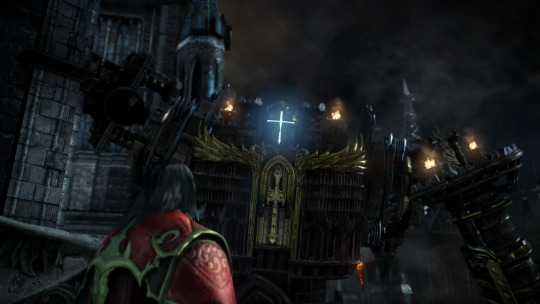
Similar to its predecessor, Lords of Shadow 2 effectively utilizes detailed environments and enemy designs to flesh out the world of the Lords of Shadow series. For instance, the game’s opening sequence depicts Dracula facing an invasion of his castle by the Brotherhood of Light’s forces, mirroring the first Lords of Shadow where the protagonist, Gabriel, was sent by the Brotherhood to defeat the three Lords of Shadow. The roles are reversed, with the protagonist now being the hunted evil. The Brotherhood’s use of Titans to siege Dracula’s castle also echoes the Titan boss battles of the first game.
During the climactic battle against a Paladin of the Brotherhood, the Paladin wields a holy crucifix and recites prayers in Latin, such as “Christus ab omni malo te defendat.” Later, players encounter other Brotherhood enemy types, including priests who also perform magical rituals using Latin incantations. This attention to detail makes the fictional Christian Holy Order of the Brotherhood of Light feel more authentic and believable, enhancing the game’s worldbuilding and immersion.
The opening narrative establishes that Dracula’s Castle has been destroyed and lies in ruins, with Castlevania City being built upon its foundations. Consequently, players will discover locations within Castlevania City that are modern reinterpretations of areas encountered in the illusory Dracula’s Castle. The game also subtly hints at the nature of the Dracula’s Castle that players explore: is it a mere illusion or a tangible place? The narrative suggests that Dracula possesses the ability to manifest his thoughts into reality, with his primary weapons, the Void Sword and Chaos Claws, being physical manifestations of his inner emotions.
6. Visual Experience
Art Style:

Dracula’s Castle in Lords of Shadow 2 heavily draws upon the dark gothic architectural style seen in the Vampire Castle sections of the first Lords of Shadow, featuring ornate carvings, elaborate chandeliers, colossal statues, and gothic spires. Each of the four distinct areas within the castle possesses its own unique characteristics, such as the lava-filled City of the Damned and the ice-covered Overlook Tower.

In contrast, Castlevania City feels like an amalgamation of Arkham City from Batman: Arkham City and Raccoon City from Resident Evil. The city streets are lined with neoclassical-style retro-modern buildings, often topped with gothic medieval roofs and gargoyles. Players engage in combat against zombie-like enemies and cyberpunk-style mechs under the cloak of night. The interiors of buildings, however, often feature modern laboratories and hospitals. I found these modern interior environments to clash with the game’s overarching dark gothic aesthetic, disrupting the sense of immersion.
Design Consistency:
The game’s environments and enemies are divided into several disparate stylistic categories.
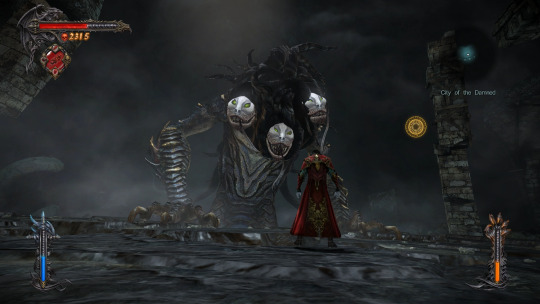
Firstly, Dracula’s Castle is a lavishly detailed dark gothic castle, populated by classic Castlevania monsters like vampires and skeletons, as well as the opposing Knights and Priests. Here, the environment and enemy styles are cohesive and align with my expectations for a 3D Castlevania game.
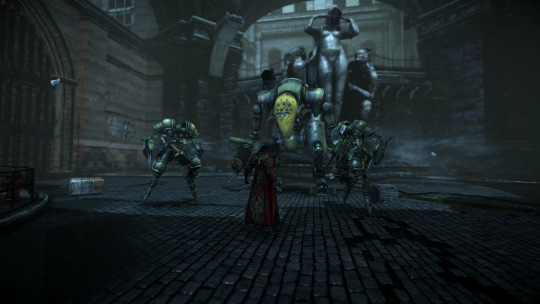
Secondly, the streets and exteriors of buildings in Castlevania City exhibit a dark gothic-infused neoclassical retro-modern architectural style, reminiscent of Arkham City. This style differs significantly from the opulent medieval architecture of Dracula’s Castle, making it feel like two distinct games. The constant transitions between the modern city and the ancient castle feel jarring. Furthermore, the enemies encountered here – zombified humans, demons, and mechs – feel stylistically out of place in a vampire-themed game. The mechs, in particular, have a purely sci-fi aesthetic that lacks any of the dark gothic elements associated with the Castlevania series, feeling like forced inclusions from another game.
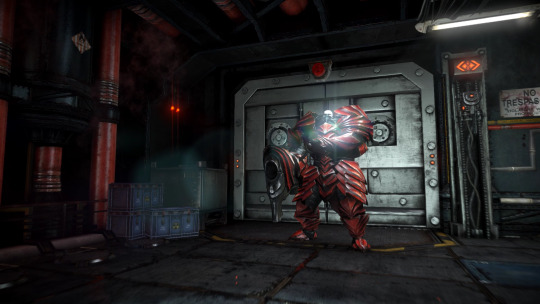
Thirdly, the interiors of buildings in Castlevania City feature numerous modern laboratories and underground passages. These indoor environments lack any details that evoke the dark gothic art style of the Castlevania series, instead resembling generic laboratories from other modern-themed games. A common enemy type in these areas is a heavily armored soldier with firearms, who cannot be attacked directly, forcing stealth gameplay. This segment of the game, with its environments and enemies, feels more like a near-future stealth game than a Castlevania title.
Therefore, the game suffers significantly from a lack of design consistency.
Detail and Impact:
The level of graphical detail in Lords of Shadow 2 is impressive, with intricate environmental details and character costume designs that hold up even in 2025. It even surpasses the visual fidelity of recent vampire-themed titles like V Rising. The opening Titan boss fight delivers a strong sense of epic scale, and the towering, ornate statues and architecture encountered during outdoor exploration also contribute to this feeling. However, regrettably, the game’s boss battles lack the awe-inspiring and epic intensity of those in the original Lords of Shadow.
7. Controls and UI
Control Convenience:
The control scheme in Lords of Shadow 2 largely inherits from its predecessor but reduces the frequency and difficulty of QTEs. The introduction of multi-directional dashing with the LT button replaces the acceleration run from the first game, which was prone to misinputs. The game also removes the need for sprint-jumps or hook swings combined with jumps to reach distant platforms in climbing and jumping sections, eliminating frustrating jump failures due to control errors or mistimed inputs.
UI Interface:
Lords of Shadow 2 retains the medieval book-style UI from the first game, contributing to the sense of immersion. However, as a 3D Metroidvania title, it only features a mini-map for the current area, lacking a comprehensive map of the entire world. This often led to disorientation when revisiting previous levels to find hidden locations, forcing me to rely on memorizing the entrances and exits of different areas. The absence of a full map makes the late-game exploration for secrets feel akin to another 3D Metroidvania game without a map – Dark Souls – where players are forced to learn the layout through repeated exploration.
8. Difficulty and Challenge
Difficulty Settings:
The game’s difficulty can be broken down into several aspects:
3D Metroidvania Exploration and Puzzles: The exploration in Lords of Shadow 2 blends elements of 3D Zelda and Castlevania: Symphony of the Night. Players will encounter numerous areas that are inaccessible with their current abilities or hidden from view. The lack of a full map and the inability to mark locations further complicate navigation, forcing players to rely on memory. The interconnected nature of many sub-areas without a comprehensive map often leads to confusion and difficulty in determining the direction of unexplored regions.
The game removes the item-based mini-game puzzles from its predecessor, replacing them with platforming puzzles. Players must observe climbable and jumpable surfaces and strategically plan their routes to reach their destinations. The removal of environmental traps also means that platforming sections are less punishing, requiring only careful observation and route planning.
Regular Combat: Compared to the first Lords of Shadow, the combat difficulty in Lords of Shadow 2 is somewhat reduced. Notably, the mechanic of initiating executions by grabbing enemies has been removed. In the previous game, executions would yield orbs for mana recovery, whereas in this installment, orbs are only dropped by defeating enemies without triggering an execution.
As mentioned earlier, the introduction of heavily armored enemies that require their armor to be broken before taking frontal damage, endlessly respawning enemies, and summoning-type enemies significantly increases the complexity and challenge of combat encounters.
To assist players struggling with combat, the game introduces several consumable items that can be used in battle, such as items that instantly restore full health, grant temporary unlimited mana, temporarily slow down time, and temporarily unlock all weapon moves. These items can be replenished at the shop, offering an option for players to alleviate combat difficulty.
Boss Battles: On normal difficulty, boss health and damage output are relatively low. Boss AOE attacks are infrequent and telegraphed with clear visual cues, allowing most players to defeat bosses on their first attempt without the need for repeated reloads.
Challenge:
The challenge in Lords of Shadow 2 primarily stems from two areas:
First, discovering hidden areas within the environments and acquiring all collectibles. Many collectibles are placed in obscure locations or require finding specific jumping paths to reach.
Second, completing the challenge modes. Collecting certain in-game items unlocks challenge modes that task players with defeating specific enemies under restrictive conditions, such as defeating heavily armored enemies without using the armor-breaking Chaos Claws.
9. Conclusion and Score
Overall Assessment:

Castlevania: Lords of Shadow 2 is an action-adventure game that attempts to blend 3D Metroidvania exploration with God of War-like hack and slash combat. The game marks a return to the Metroidvania exploration mechanics of the Castlevania series, with players utilizing abilities to access new areas and uncover hidden collectibles across two distinct large maps, one of which, Dracula’s Castle, feels like a 3D reimagining of classic Castlevania environments. However, the mandatory stealth sections feel tedious, and the inclusion of modern city and mech elements clashes with the traditional medieval aesthetic of the Castlevania series. These flaws prevent what could have been a new pinnacle for the franchise from achieving its full potential, ultimately making it a somewhat disappointing final major entry. Nevertheless, if one can overlook the jarring modern city elements and forced stealth sections, Castlevania: Lords of Shadow 2 remains a visually impressive and fluidly combat-driven vampire-themed game in 2025. It also stands as one of the few titles outside of the Darksiders, Batman: Arkham, and STAR WARS Jedi series to offer a 3D Metroidvania-style open-world exploration experience.
Pros:
Return of Castlevania series’ Metroidvania exploration in a 3D open-world format
Excellent combat experience and hit feedback
Gorgeous dark gothic art style and environmental detail
Cons:
Stylistic clash between the Vampire Castle and modern city maps
Tedious mandatory stealth elements
Out-of-place mech-type enemies
Abrupt and underdeveloped plot
Who Should Play:
Die-hard fans of the Castlevania series, enthusiasts of Metroidvania games.
Score:
Gameplay: 7/10
Story: 7/10
Graphics: 9/10
Controls: 8/10
Overall: 7/10
2 notes
·
View notes
Text
The Last Metroidvania Castlevania – Castlevania: Lords of Shadow – Mirror of Fate Review
1. Introduction
Game Title: Castlevania: Lords of Shadow – Mirror of Fate
Release Date: Mar 28, 2014 (PC)
Game Genre: Metroidvania, 2D Platformer, Action-Adventure
Game Length: 8-12 hours
Overview:
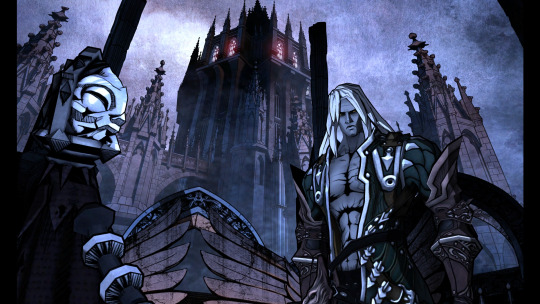
The Castlevania series is a key origin for the Metroidvania gameplay style. However, the series reboot, Castlevania: Lords of Shadow, abandoned this classic formula and become a linear, old God of War-like 3D Action-Adventure approach. In contrast, Mirror of Fate, a spin-off from Lords of Shadow, stands as Konami's last Castlevania title to embrace the Metroidvania style. Unlike classic Castlevania entries such as Symphony of the Night and Harmony of Dissonance, which incorporated RPG elements, Mirror of Fate retains only the core Metroidvania aspects: open exploration of side-scrolling maps and the mechanism of acquiring key items to access specific areas and uncover hidden treasures.
2. Gameplay Mechanics
Multi-Character Linear 2D Metroidvania Map Exploration:
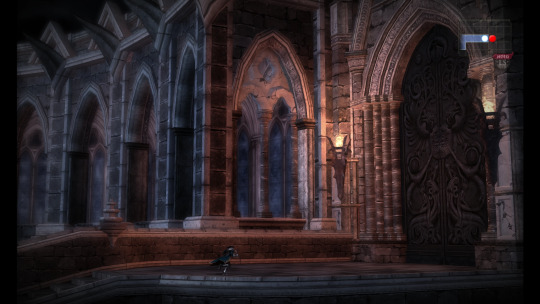
Players will explore various areas within Vampire Castle, much like in classic 2D Metroidvania Castlevania games, solving puzzles, navigating traps, obtaining crucial items, reaching hidden zones, and battling dark creatures and bosses. However, the map exploration experience in this title is fairly linear. Players will progress through environments in a set order, lacking the freedom to choose which area to explore first.
Unlike typical Metroidvania games that focus on controlling a single character across one map, Mirror of Fate features three Acts with three unique characters and three unique maps. Each Act plays a different character, each act with unique areas and enemies. Even when revisiting the same locations, the level layouts and traps vary significantly depending on the character being played, providing a constant sense of novelty. Regrettably, the environments in all three Acts are quite small, resulting in a shorter playtime compared to other Metroidvania titles.
2D Platformer Hack and Slash:
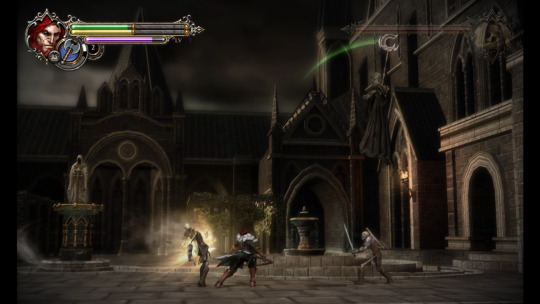
The combat in Mirror of Fate mirrors is similar to its predecessor, Lords of Shadow. Players wield the "Combat Cross," a metal whip, as their primary weapon, along with two ranged sub-weapons and two different skills for each character. Various moves are executed by pressing the X and Y buttons in specific combinations.
The combat experience has been improved from Lords of Shadow. Mirror of Fate inherits most of the previous game's moves while simplifying the execution of many, making them more practical in actual combat rather than being difficult to trigger. Enemy hit reactions and stun states are noticeably better than in the previous installment, contributing to a relatively polished combat experience within the 2D Metroidvania genre.
Compared to Lords of Shadow, the frequency of Quick Time Events (QTEs) has been reduced considerably, though the time windows for QTE inputs remain quite short.
The combat in Mirror of Fate has three main drawbacks: 1. Boss numbers are limited, and their attack patterns lack variety. 2. Although each Act features a different character, they share the same weapon and move set, which can feel repetitive. 3. While each Act's characters have unique skills, they are fundamentally similar: the LB button is used for skills that restore health or provide damage immunity, and the RB button triggers skills that increase damage output or add new attack methods.
2D Platformer Jumping and Climbing:
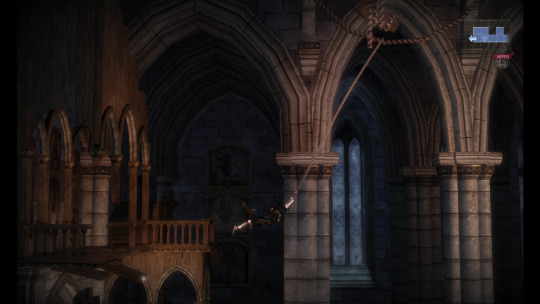
The game features numerous cliffs, platforms, and caverns that players must navigate through jumping and climbing. Many areas include traps, such as fireball launchers or spikes, requiring players to dodge these hazards while timing their jumps carefully.
Compared to Lords of Shadow, Mirror of Fate has fewer punishing timed-trap mechanics, like rising lava. As a result, the difficulty of platforming and climbing is reduced.
3. Growth Elements and Collectibles
Move Unlocking and Skill Acquisition:
Players earn experience points (XP) by defeating enemies, and leveling up occurs when a certain amount of XP is gained. However, leveling up does not increase a character's attack power or maximum health; instead, each level unlocks a new move. All three Acts' characters share the same pool of XP and levels, eliminating the need to re-level when switching to a new character.
Throughout the main story, the protagonists of each of the three Acts acquire their own unique skills. For example, Simon, the protagonist of Act 1, can summon two spectral allies: a female spirit that grants temporary damage immunity and a male spirit that attacks enemies from a distance. Alucard, the protagonist of Act 2, can transform into mist to teleport behind enemies or assume a beast form to boost his base attack damage. Trevor, who stars in Act 3, inherits the Light and Dark Magic from Lords of Shadow. Light Magic allows him to recover health with each successful attack, while Dark Magic enhances his base attack power.
Collectibles and Hidden Content:
There are five types of collectibles scattered throughout each game environment: items that increase maximum health, magic capacity, and ammunition; scrolls that provide backstory; and bestiary entries that detail enemy information. Most of these collectibles are located in easily overlooked hidden areas or zones that require specific key items to access.
4. Unique Flavor
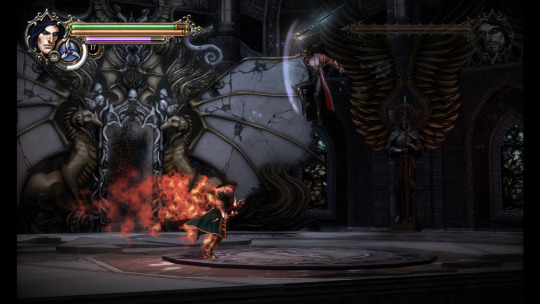
While Castlevania: Lords of Shadow – Mirror of Fate lacks the RPG elements of classic Metroidvania Castlevania titles, it retains the core map exploration of the Metroidvania genre, along with the Castlevania series' typical dark gothic art style and battles against classic Castlevania monsters like werewolves, skeletons, and vampires.
With no new 2D Metroidvania Castlevania game released in 17 years, Mirror of Fate is the most recent entry in this style. Although Steam boasts a large library of Metroidvania games, only titles from the Castlevania series itself or Bloodstained: Ritual of the Night (created by Koji Igarashi) truly capture the classic Castlevania feel.
5. Story and World-Building
Story Summary:
Mirror of Fate bridges the gap between Lords of Shadow and Lords of Shadow 2. Set decades after Gabriel's transformation into Dracula at the end of Lords of Shadow 1, the story follows Simon, guided by fate, as he ventures to Dracula's castle to confront the vampire lord. Simon is aided by Dracula's son, Alucard, and together, they defeat Dracula. The game also chronicles the origin of the iconic character Alucard from Trevor's perspective.
Characters and Depth:
Lords of Shadow reimagined Dracula's origins, portraying Gabriel as a human who challenged the Lords of Shadow to resurrect his wife. In contrast, Mirror of Fate radically reinterprets the backstories of three classic Castlevania protagonists: Simon, Alucard, and Trevor. Simon, traditionally a descendant of a vampire-hunting lineage, is now Gabriel's grandson. Alucard, known in Castlevania: Symphony of the Night as the half-human, half-vampire son of Dracula, is now Trevor, the human son of Gabriel (while he was still human) and his wife, Marie. After Trevor is killed challenging Dracula, Dracula transforms him into the vampire Alucard using his own blood.
The game features minimal cutscenes and dialogue, leaving the characters of Simon, Alucard, and Trevor relatively undeveloped. The floating mask that guides the player throughout the game remains unidentified until the bestiary is unlocked upon completing all three Acts, revealing it to be Fate itself.
World-Building:
As a connecting piece between Lords of Shadow and Lords of Shadow 2, Mirror of Fate includes numerous details that align with the lore established in those games. For instance, players visit the Games Room where Gabriel and Laura played chess in Lords of Shadow , and the hidden underground passage from that room is also present.
One of the bosses, the Necromancer, serves Zobek rather than Dracula, consistent with the plot of Lords of Shadow and foreshadowing Zobek's return in Lords of Shadow 2.
In Act 3, Trevor acquires the Light and Dark Magic previously wielded by Gabriel, and during Trevor's confrontation with Dracula, Dracula uses the Void Sword and Chaos Claws, his signature weapons from Lords of Shadow 2.
Additionally, key plot elements from Lords of Shadow 2, such as the "Mirror of Fate" and the "Toy Maker," make early appearances in this game. The overall aesthetic of the environments also matches the Vampire Castle setting seen in Lords of Shadow and Lords of Shadow 2.
6. Visual Experience
Art Style:
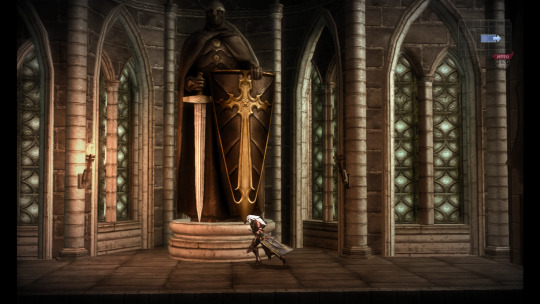
Mirror of Fate employs the same dark gothic art style as Lords of Shadow, presented in a 2.5D side-scrolling format.
However, the character designs shift from the realistic style of Lords of Shadow to a 2.5D animated, cartoonish aesthetic. This cartoon style leaves a lasting impression.
Design Consistency:
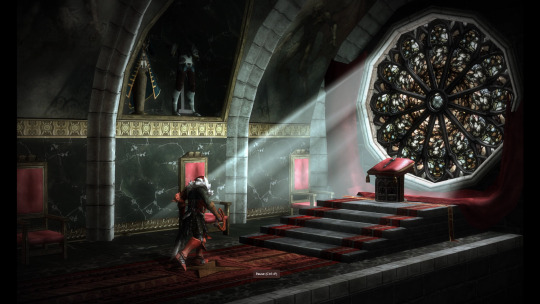
The new environments and enemy designs in Mirror of Fate are consistent with those found in classic 2D Castlevania titles. Iconic locations like the Clock Tower, Unholy Church, and library reappear in this game.
Furthermore, the environments, enemy designs, and main weapons from Lords of Shadow are largely unchanged in Mirror of Fate.
Detail and Impact:
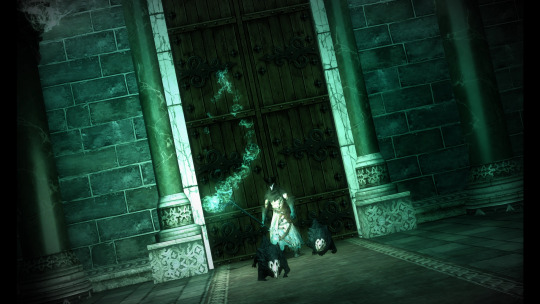
Originally a 3DS title, Mirror of Fate suffers from relatively simple and rough models for environments, characters, and enemies due to the handheld's technical limitations. This results in a lack of the stunning environmental detail seen in Lords of Shadow, which is regrettable, as this is Konami's final 2D side-scrolling Metroidvania Castlevania game.
7. Controls and UI
Control Convenience:
Mirror of Fate significantly reduces the frequent QTEs of its predecessor, and the button inputs for executing moves have been simplified. Players can execute various moves more easily, resulting in a much-improved combat and platforming experience compared to Lords of Shadow.
UI Interface:
Compared to the elaborate medieval manuscript-style UI of Lords of Shadow, the UI elements in Mirror of Fate, while straightforward and functional, lack a certain refinement.
8. Difficulty and Challenge
Difficulty Settings:
The game's difficulty can be broken down into three areas:
Regular Combat: Unlike Lords of Shadow, where players could grab and execute regular enemies, Mirror of Fate requires enemies' health to be reduced to a certain point before a finishing move can be performed. However, these executions no longer involve QTEs, eliminating the possibility of failure due to missed inputs.
Ranged sub-weapons deal considerably more damage in Mirror of Fate than in Lords of Shadow, allowing players to dispatch many troublesome enemies with ease.
Similar to the Light and Dark Magic system in Lords of Shadow, the three protagonists in Mirror of Fate can expend magic (Mana)to activate skills that restore health or increase damage output. In particular, Simon, the first protagonist, can use Mana to gain temporary invincibility, which greatly reduces the challenge of combat.
Boss Fights: Compared to the boss fights in Lords of Shadow, those in Mirror of Fate feature far fewer QTEs, and bosses have fewer attack patterns. As a result, boss battles are generally less challenging. By learning a boss's attack patterns, players can often defeat them without taking damage.
2D Platforming: The platforming in Mirror of Fate is less demanding than in Lords of Shadow. While some areas with fire-breathing traps pose a challenge, a notable difficulty spike occurs in a section with a giant rolling ball that chases the player, requiring precise and rapid jumps. However, this type of sequence appears only once. Overall, the platforming in this game is largely unchallenging.
Challenge:
The greatest challenge in Mirror of Fate lies in achieving 100% completion of all hidden areas. Unlocking the final story sequence requires players to collect every hidden item in all three Acts. However, the solutions to many of these hidden area puzzles are quite challenging, and I, myself, did not manage to achieve full completion.
9. Summary and Score
Overall Assessment:
Mirror of Fate is a representative Metroidvania Castlevania title. However, compared to the classic 2D Metroidvania Castlevania games on the GBA and NDS, it features smaller maps, less room for exploration, and a lack of RPG elements. Compared to other Metroidvania games on the market, Mirror of Fate offers relatively polished combat and satisfying hit feedback. If you are a dedicated fan of 2D Metroidvania Castlevania games and enjoy exploring dark gothic environments, Mirror of Fate is an acceptable substitute.
Pros:
Classic Castlevania locations and enemies return.
Relatively polished combat and satisfying hit feedback for a Metroidvania title.
A large variety of unique level designs and enemies.
Cons:
Small map size with limited exploration.
Lacks the iconic RPG mechanics of the 2D Metroidvania Castlevania series.
Simplistic graphics.
Repetitive and unchallenging boss attack patterns.
Target Audience:
Fans of 2D Metroidvania Castlevania games and Metroidvania enthusiasts.
Score:
Gameplay: 6/10
Story: 6/10
Art: 7/10
Controls: 7/10
Overall: 6/10
2 notes
·
View notes
Text
The Weight of Dust Chapter 30: The Weight Released
The cell’s stone wept with frost as Eleanor lay on the floor, her chains a cold embrace around her wrists. Fever burned beneath her skin, her cough a wet rasp that stained the dark with blood—Thornfield’s dust, her blood’s loss, now claiming their due. The slit above offered no light, only a whisper of Wolthrope’s wind, and she shivered, her patched dress a frail shroud. Eldric’s death, Margaret’s, Henry’s—they pressed on her chest, a millstone she could no longer bear.
Shadows danced, and she saw them—James, tall in his redcoat, grinning; Eldric, his bird aloft, laughing; Margaret and Henry, hands clasped, humming her lullaby. “I’m with you now,” she whispered, her voice a thread snapping, and reached for them, her trembling fingers brushing air. The fever flared, a tide of heat and haze, and their faces sharpened—love’s cruel mirage calling her from the dark. Her breath faltered, a shallow ebb, and she tasted salt, her tears mingling with the damp beneath her cheek.
The gaol was silent, its walls a mute witness to her end—Wolthrope’s mills thrummed beyond, their roar a requiem for a life ground to ash. She’d fought with every sinew—looms, blood, theft—yet the king’s decrees, the mill’s hunger, the law’s chains had won. Her family faded, their warmth a memory she could not hold, and she felt the weight lift—not in triumph, but surrender, her spirit spilling free like dust on the wind.
Her eyes fluttered shut, the slit’s gray extinguished, and she sank into the floor, a frail husk in a world that forgot her name. The chains clinked, a final note, as her breath ceased—a mother, a daughter, a widow, released at last from the ashes of her toil. Wolthrope churned on, its smoke curling skyward, and Eleanor Harrington vanished, her story a whisper lost to the city’s ceaseless grind, her love buried in the silence of a pauper’s grave.
3 notes
·
View notes
Text
The Weight of Dust Chapter 29: The Cell’s Silence
The gaol’s cell was a crypt of stone, its air thick with damp and the tang of rust as Eleanor sat shackled, her wrists raw beneath the irons. A single slit let in Wolthrope’s gray dawn, a cruel sliver of a world she’d lost. Her cough echoed, a hollow lament, and she clutched her patched dress, its threads unraveling like her life. She’d sung Eldric’s bird song to the dark—“Fly, my love”—a whisper to keep him near, though the silence mocked her, a void where his voice should be.
A guard shuffled past, his boots a dull thud, and paused, his face a mask of indifference. “Your lot’s gone,” he muttered, words blunt as stone. “Boy starved, old ones too—slum took ’em.” The air fled her lungs, her heart a shattered thing—Eldric, her light, starved without her; Margaret and Henry, adrift, claimed by neglect. She collapsed, a wail tearing free, “I was supposed to save you!”—a cry swallowed by the walls, her chains rattling like a mourner’s dirge.
She saw them—Eldric’s bird still in his hand, Margaret’s hum silenced, Henry’s grasp cold—and her mind broke beneath the weight. The mill, the blood, the theft—all for naught, her love a frail shield against a world that devoured. Her cough deepened, blood flecking her lips, and she pressed her face to the floor, its chill a mirror to her despair. James lingered in the shadows, his coat a ghost she could not touch, and she whispered, “Forgive me,” to the dark.
The gaol’s silence was a tomb, Wolthrope’s mills a distant roar beyond the stone—life grinding on, heedless of her ruin. She’d fought, bled, stolen, yet her family slipped away, their deaths a sentence she bore alone. The slit’s light faded, dusk creeping in, and she curled into herself, a husk in chains, her spirit fracturing as the abyss claimed all she’d held dear.
0 notes
Text
The Weight of Dust Chapter 28: The Constable’s Chains
Dawn broke over Wolthrope, a bleak smear of light as Eleanor slipped from the tenement, her shawl a tattered shroud. Hunger had hollowed them—Eldric’s cough a faint echo, Margaret and Henry shadows of breath—and the loaf’s memory drove her back to the bakery, its warmth a cruel lure. She lingered by the counter, the scent of bread a torment, and when the baker turned, she snatched a crust, her hands trembling with shame. She fled, the bell’s clang a knell, but a cry—“Thief!”—pierced the air, and boots thundered behind.
Constable John Harrow loomed, broad and stern, his uniform frayed at the cuffs. “You’re caught,” he growled, seizing her arm, and she stumbled, the bread tumbling to the mud. “My son can’t walk, my parents can’t think!” she pleaded, her voice a sob, tears streaking her dust-caked face. “They’ll die without me!” His jaw tightened, eyes hard beneath his cap. “Law’s the law,” he said, and the irons snapped shut, cold and unyielding, biting her wrists. The crowd jeered, their scorn a lash, and she bowed her head, a mother broken by her own hand.
He dragged her through Wolthrope’s mire, the river’s chill seeping into her bones, James’s coat left behind—a mute mourner. The gaol loomed, its stone walls a tomb, and she thought of Eldric’s bird, Margaret’s hum, Henry’s grasp—left to fade in the tenement’s gloom. Her cough rasped, a dirge for her failure, and she saw their faces in the fog, her pleas unheard by a world that turned its back. Harrow shoved her into a cell, the door clanging shut, and she sank to the damp floor, chains a weight she’d forged.
The candle’s glow was gone, replaced by darkness thick as coal dust, and she pressed her hands to her face, tasting salt and despair. She’d stolen for love, yet these chains severed her from them, a final stroke in a life bled dry by want and woe.
0 notes
Text
Lords of Shadow: A Old God of War Like Castlevania Reboot
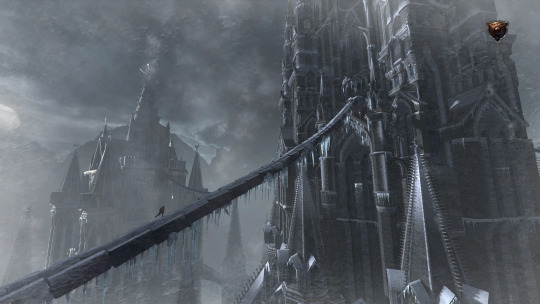
1. Introduction
Game Title: Castlevania: Lords of Shadow
Release Date: October 5, 2010
Game Genre: Action-adventure, Hack and Slash
Game Length: 30-35 hours
Overview:
The Castlevania series is the originator of the classic 2D side-scrolling METROIDVANIA game formula. However, Castlevania: Lords of Shadow, as a reboot of this classic series from 15 years ago, is not a typical 2D side-scrolling METROIDVANIA game. Instead, it's a quintessential 3D Old School God of War-like experience, featuring a dark fantasy gothic art style and classic Castlevania elements such as Werewolf, Vampires, and undead creatures. Yet, its gameplay leans more towards the 3D platforming, climbing, jumping, puzzle-solving, and hack and slash of Old School God of War. Narratively, Lords of Shadow returns to the origin of the Castlevania series' story. This time, players take on the role of the series' iconic antagonist, Dracula, in his former life as Gabriel, recounting his journey as a human battling the three Lords of Shadow to revive his deceased wife. Players will navigate dark fantasy gothic environments, climbing, jumping, solving puzzles, and engaging in combat against dark creatures, culminating in Old School God of War-style Boss Fights.
2. Gameplay Mechanics
Old School God of War Type Hack and Slash and Boss Fights
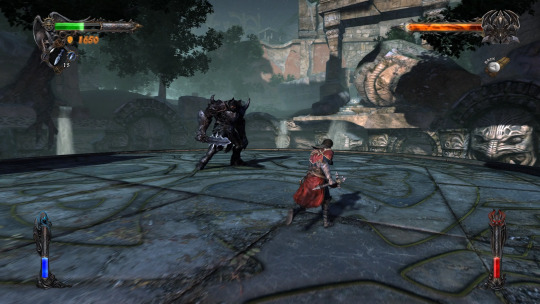
In the game, players wield an iron whip called the Combat Cross as their main weapon. Its attack style mirrors the Blades of Chaos from God of War, with players executing different moves by pressing the XY buttons.
Players can also press the B button to unleash classic Castlevania ranged secondary weapons like the Dagger and Holy Water, weakening enemies from a distance. There are four distinct secondary weapons, each suited for different enemy types. For instance, the Dagger is effective against Lycanthropes, while Holy Water is used to vanquish Vampires.
A really interesting mechanic here is Combat Focus. If you can manage to hit enemies a certain number of times in a row without getting hit yourself, you enter this state. While in Combat Focus, every single hit you land generates a Nature Orb. As long as you keep the combo going and avoid taking damage, you can essentially generate an unlimited supply of these orbs. Besides Combat Focus, you'll also get Nature Orbs for executing enemies with those cinematic QTE finishers or just by defeating them with regular attacks. These Nature Orbs are your fuel for both Light and Dark Magic.
Players will encounter foes such as Werewolves, Vampires, and Titan Golems. Each boss has unique vulnerabilities, and many require specific mechanics to expose and damage their weak points. Furthermore, numerous boss encounters demand the timely input of correct Quick Time Events (QTEs) to secure victory. Some of the giant boss battles' QTE mechanics felt boring and like a waste of time.
Certain specific monsters, like the Giant Warg or Giant Spider, can be mounted after being stunned by player attacks. While mounted, players can swiftly clear out enemies or utilize these creatures' special abilities to solve puzzles.
Light Magic and Dark Magic
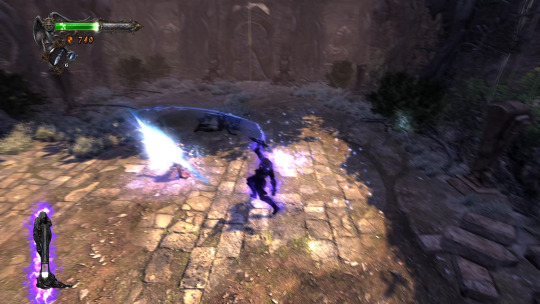
Throughout the game, players will unlock both Light Magic and Dark Magic. Unlike mages in other games who cast spells remotely as an attack, players here consume Mana to imbue their Combat Cross with either Light or Dark energy. When Light Magic is active, striking enemies with the Combat Cross restores health. Conversely, when Dark Magic is active, it increases the base damage of each Combat Cross attack.
While either Light or Dark Magic is active, players can expend Mana to alter the functionality of their secondary weapons. For example, Dark Magic can transform the Dagger into a Fire Dagger, while Light Magic can convert Holy Water into a magical protective barrier. Players can also consume a significant amount of Mana to unleash area-of-effect attacks with either Light or Dark Magic.
Light Magic and Dark Magic each draw from separate Mana pools. Each time a player defeats an enemy, they drop Nature Orbs, which can be absorbed and converted into Mana for either Light or Dark Magic.
Climbing and 3D Platformer Jumping
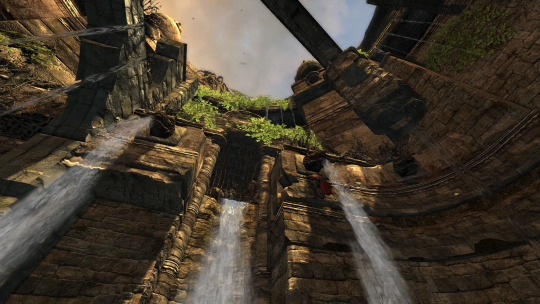
Players will need to navigate numerous cliffs through climbing and jumping, as well as swing across various locations in a Tarzan-like fashion. Often, players will face perilous environments such as collapsing cliffs or rising lava, requiring them to complete climbing, jumping, and swinging sequences within a limited timeframe. These 3D platformer sections constitute roughly a quarter of the game's levels.
Box-World Puzzles
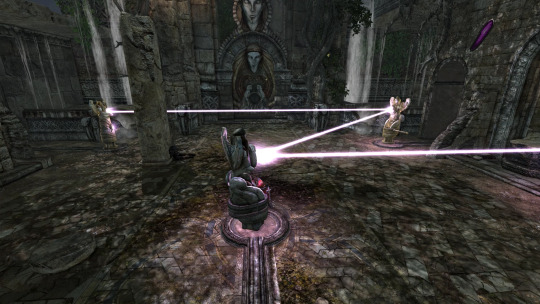
The game features numerous Box-World Puzzle levels, where players must explore to find puzzle items and engage in mini-games to solve them. These puzzles are not repetitive, and many require the use of new abilities unlocked after defeating bosses. Some puzzle levels also test the player's dexterity.
3. Progression and Collectibles
Skill Tree and Ability Upgrades
Players earn experience points by defeating enemies, which can be spent to unlock new moves. There are over a dozen moves available for unlocking, but only 2-3 tend to be the most practical in combat.
Progressing through the game and defeating key bosses unlocks new abilities, such as a dash, double jump, and a gauntlet capable of moving boxes. Certain levels also contain locations where players can upgrade their Combat Cross, granting new puzzle-solving capabilities. However, there are no upgrades that directly increase attack power.
Collectibles and Hidden Content
There are four types of collectibles scattered throughout each game level: Life Gems, Light Gems, Dark Gems, and Scrolls. Collecting five Life Gems increases the player's maximum health, five Light Gems increase the maximum Light Magic Mana, and five Dark Gems increase the maximum Dark Magic Mana. Scrolls primarily provide background lore, while some offer hints for puzzles.
4. Unique Flavor
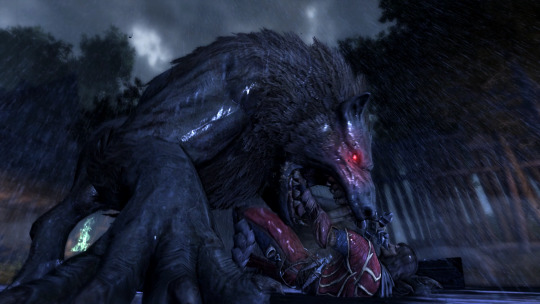
While Castlevania: Lords of Shadow departs from the traditional 2D METROIDVANIA gameplay of the Castlevania series, it heavily incorporates the classic dark fantasy gothic art style of the franchise within an Old School God of War framework. Players will battle dark creatures such as Vampires, Lycanthropes, Zombies, and Skeleton Warriors in classic Castlevania settings like vampire castles, forests, and ruins.
Considering that in 2025, both Old School God of War-style games and Vampire or Werewolf-themed games are relatively scarce, Castlevania: Lords of Shadow stands out as one of the few quality titles in this vein.
5. Story and Lore
Story Overview
The story follows Gabriel, a member of the Light Brotherhood. After his wife Marie is murdered, he learns that defeating the three Lords of Shadow can grant him the God Mask, capable of resurrecting her. He embarks on a quest to vanquish these lords alongside Zobek, another member of the Brotherhood. During his journey, he receives aid from Pan, Claudia, the Vampire Laura, and Baba Yaga. However, these allies ultimately meet their demise. In the end, he discovers Zobek's betrayal and that Gabriel was manipulated into killing his own wife, Marie. The narrative culminates in Gabriel's transformation into Dracula, the iconic antagonist of the Castlevania series.
Characters and Depth
While the game doesn't feature an abundance of cutscenes, the characterizations of Gabriel, Zobek, Pan, Claudia, and Laura are all memorable. Each level begins with Zobek narrating Gabriel's journey, allowing players to witness Gabriel's psychological evolution.
The game contains numerous Brotherhood Knight Scrolls, offering accounts of their experiences from their perspective. Regrettably, these scrolls fail to build truly memorable characters or significantly enrich the game's world-building and lore.
World Building
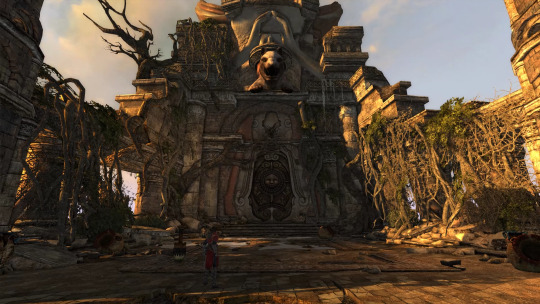
The game comprises 14 chapters and 51 levels, with each level featuring unique environments that correspond to the Boss encountered within, enhancing the believability of the world.
The primary settings in the game are thematically linked to the three Lords of Shadow. For example, the early Agharta ruins correspond to the Lycanthrope Lord, the mid-game Vampire castle to the Vampire Lord, and the later stages to the Necromancy Lord.
Early levels see players venturing through the ancient civilization ruins of Agharta, a magical civilization predating Rome and ancient Greece, capable of creating Titan Golems, but destroyed during The Necromantic Wars. These Agharta environments boast a distinct and unified ancient civilization art style, making it seem as though a civilization called Agharta truly existed.
In the mid-game, players witness Ghouls invading a town while the Monks, who should be protecting the people, hide within their Abbey shielded by Holy Relics, leaving the populace to the Vampires and Ghouls. As players enter the Vampire castle, they encounter the classic gothic splendor of the Castlevania series. Some scenes allow players to draw back curtains, exposing Vampires to sunlight and weakening them, adhering to classic vampire lore. Within the Vampire castle, players also encounter anachronistic electrical installations, a clear nod to the classic dark fantasy character Frankenstein.
I found the setting of the early and mid-game levels highly satisfying. However, the later levels associated with the Necromancy Lord didn't align with my preconceived notions of Necromancy in most fantasy settings. I expected more tomb-like elements, but instead, the game presented numerous Titan Golem ruins and cliffs, environments not typically associated with necromantic themes.
6. Visual Experience
Art Style
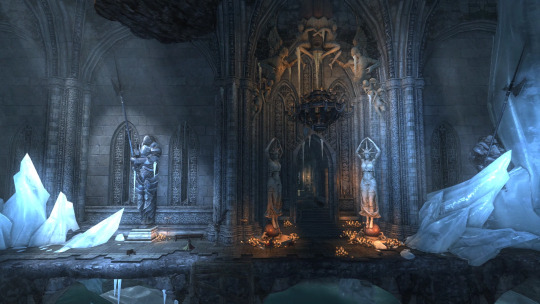
The game employs the classic dark gothic art style of the Castlevania series. Additionally, the levels within different chapters feature art styles that correspond to the narrative backdrop of that chapter. For instance, the early Agharta ruins heavily utilize female face reliefs to reflect the architectural style of this fictional civilization, while the mid-game Vampire castle showcases opulent medieval gothic architecture. Overall, the game's art style is outstanding, perfectly inheriting the memorable dark gothic aesthetic of the 2D Castlevania games and translating it into grand 3D environments akin to those in God of War.
Design Consistency
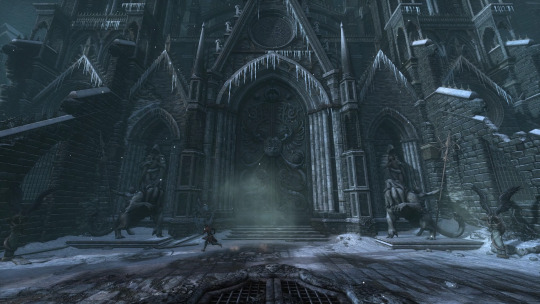
The overall art style of the game maintains a dark fantasy gothic aesthetic, and the monster and puzzle designs within each level generally align with the style of the current environment. However, the frequent appearance of differently colored portals in the later levels detracts from the established art style of the earlier parts of the game, regrettably preventing the art design from achieving perfection.
Detail and Impact
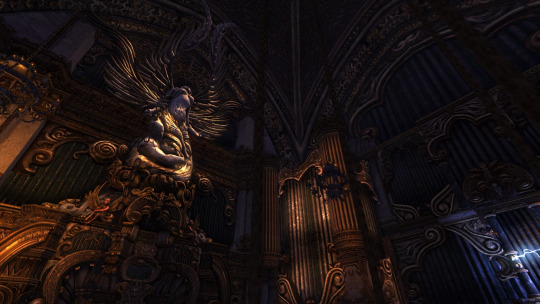
Even in 2025, the visuals of Castlevania: Lords of Shadow still hold up. The game's environments are rich in elaborate details, particularly the Vampire castle sections in the mid-game. Players will explore multiple distinct areas, each adorned with intricate decorations. This is the most complex and ornate Vampire castle I have encountered in my gaming career, and it remains a highlight of the game for me.
7. Controls and UI
Control Convenience
Due to the Light Magic and Dark Magic mechanics, players must press the left analog stick to absorb Nature Orbs for Light Magic Mana and the right analog stick for Dark Magic Mana whenever enemies drop them. Furthermore, activating Light Mode requires pressing the LB button, while Dark Mode is activated with RB. This setup can easily lead to mispresses during tense Boss battles.
Moreover, the game features numerous run and jump sequences, and sprinting requires quickly pressing the left analog stick twice, which can inadvertently result in absorbing Nature Orbs instead of initiating a sprint.
Boss battles in this game frequently feature QTEs, and many specific bosses cannot be damaged through normal attacks. The Titan Golem Boss fight, in particular, requires players to climb and jump onto the boss's weak points, transforming the encounter into an unconventional 3D Platformer Jumping game, making the entire Boss fight feel boring.
Most Boss Fights are divided into multiple phases, requiring players to damage the boss to a certain extent before initiating a series of QTEs to progress to the next phase. Failing a QTE will restore the boss's health to the beginning of that phase, forcing players to inflict the necessary damage again to trigger the QTE once more for a chance at victory. Additionally, many of the game's QTEs have very short time windows, making it easy for players to fail due to mistimed inputs or mispresses, ultimately making Boss Fights one of the most frustrating and tedious aspects of the game.
UI Interface

The game's UI interface is simple and intuitive. Additionally, the main characters and monsters encountered throughout the game have detailed background information available in an encyclopedia, and the game's moves are accompanied by control guides explaining how to execute them.
8. Difficulty and Challenge
Difficulty Settings
The game's difficulty can be broken down into four aspects:
Regular Combat: Many low-level enemies in the game can be instantly executed via a Grab, and successfully completing a QTE during the execution yields a significant amount of Nature Orbs for the player to absorb. Furthermore, activating Light Mode allows players to regain health with each successful hit, ensuring that as long as non-elite, low-level enemies are present, players can quickly recover health and rarely die in regular combat.
Boss Fights: Bosses in the game primarily damage players with standard attacks, and their attack speed is generally not fast, providing players with ample time to dodge or block. Area-of-Effect (AOE) attacks are not frequent and are often easily avoided by jumping.
However, defeating bosses requires executing them via QTEs, and the time windows for these QTEs are short. Mistake can cause the boss to break free from the execution state and regain health, making QTEs and the need to attack specific weak points the main challenges in the game's Boss Fights.
3D Platformer: The early platforming sections of the game are relatively easy, with clear visual cues indicating climbable areas, and failure due to control errors is uncommon. However, the later parts of the game introduce numerous trap-based mechanics, such as collapsing cliffs, rising lava, rotating blades, and electrified corridors. A single misstep can lead to instant death, and the timing windows for many of these late-game traps are very short, testing the player's dexterity.
Box-World Puzzles: The Box-World Puzzles in the game follow a consistent pattern: explore the Box-World to find puzzle items -> place the puzzle items in their corresponding locations -> engage in a mini-game -> solve the puzzle. Almost all of the puzzles are straightforward, and the few challenging ones can be bypassed by forfeiting the reward to view a Puzzle Scroll or the correct solution.
Challenge
Completing all the levels in the game is not particularly difficult. However, the real challenge lies in avoiding enemy hits in combat and executing advanced moves by inputting the correct button combinations. Successfully dodging enemy attacks and unleashing advanced moves can result in stylish combat sequences reminiscent of Devil May Cry, offering a significant sense of accomplishment.
9. Conclusion and Score
Overall Evaluation
Castlevania: Lords of Shadow is an excellent Old School God of War-style game with a Vampire and Werewolf theme. It boasts a striking and distinctive art style and a satisfying combat experience, blending in a significant amount of Climbing and Platformer Jumping gameplay alongside Box-World Puzzles. Despite abandoning the classic METROIDVANIA formula of the Castlevania series, it stands as a commendable title in the God of War-like genre.
Pros
Gorgeous dark fantasy medieval gothic art style
Game mechanics that blend multiple gameplay styles
A large number of unique level environments and monsters
Cons
Boring and easily failed QTEs
Challenging trap-filled levels
Suitable For
Fans of Old School God of War-style games, enthusiasts of Vampire and Werewolf themes, and loyal fans of the Castlevania series.
Score
Gameplay: 7/10
Story: 7/10
Art: 9/10
Controls: 6/10
Overall: 8/10
2 notes
·
View notes
Text
The Weight of Dust Chapter 27: The Final Night
Night draped Wolthrope in a shroud of frost as Eleanor sat by the hearth, its embers a dying whisper in the tenement’s chill. Her cough rasped, a hollow echo, and her hands—scarred, bloodless—rested limp in her lap. The bloodletter’s scorn had left her empty, the shilling unclaimed, and hunger’s grip tightened—Eldric’s bird lay still, his breath a faint thread, while Margaret’s silence and Henry’s wheeze wove a dirge she could not escape. She lit a taper, its flame a frail sentinel, and turned to her kin, her heart a wound too deep to mend.
Eldric stirred, his bent legs tangled in the quilt, and she lifted him, his weight a wisp against her chest. “Sleep, love,” she sang, her voice a broken lullaby—“Hush, my babe, the wind doth sigh”—and his eyes fluttered, the wooden bird pressed to his cheek. Margaret rocked, her hum faint, a snatch of the tune rising from her fog, and Eleanor’s throat burned—her mother’s voice, once a balm, now a ghost joining her song. Henry’s hand twitched, as if reaching, and she clasped it, its coldness a mirror to her dread.
The room softened, shadows stretching like mourners, and she held them close—her son, her parents—in this final night, a fragile communion. James’s coat hung on the peg, its wool a silent witness, and she felt him in the stillness, his absence a weight she bore alone. Wolthrope’s mills growled beyond the cracked panes, their rhythm a knell, and she kissed Eldric’s brow, tasting her tears. “My brave boy,” she whispered, knowing dawn would bring no mercy.
The candle guttered, wax pooling like her grief, and she gazed at them—Eldric’s trust, Margaret’s drift, Henry’s fade—slipping from her grasp. She’d fought, bled, stolen, yet this night marked her surrender, a mother’s love powerless against the dark tide rising. The fire dimmed, and she clung to their frail warmth, a sentinel to their end, her spirit breaking under the ashes of defeat.
0 notes
Text
The Weight of Dust Chapter 26: A Desperate Stand
The dawn crept into Wolthrope, a pall of frost and soot as Eleanor rose from the hearth, her cough a jagged hymn to her ruin. The last supper’s crumbs were gone, Eldric’s cheeks hollower still, and Margaret’s murmurs had stilled to a faint breath, Henry’s stare fixed on nothing. Hunger gnawed them raw, and she felt its teeth in her own bones—Thornfield’s dust, her blood’s loss, had left her a husk, yet she could not yield. She donned James’s coat, its wool a frail armor, and slipped out, seeking the bloodletter once more.
The alley reeked of brine and rot, the hovel’s door sagging as she entered, her steps a falter. The man squinted, his needle glinting in the dim. “Back again?” he growled, and she bared her arm, its veins faint beneath bruised skin. “Another shilling,” she rasped, her voice a plea, but he shook his head, jabbing the steel. Blood trickled, too slow, too thin—she swayed, the room tilting, and he cursed, “You’re spent, woman.” She clutched the wall, dizziness a tide, and staggered out, empty-handed, her stand a failure.
Homeward, she leaned on the coat, its weight her only prop, the river’s chill biting her face. Eldric waited, his bird clutched tight, his eyes sharp with worry. “Mama,” he whispered, and she sank beside him, her breath a gasp. “I’ll always fight for you,” she said, her voice cracking, and held him close, his frail warmth a dagger in her chest. Margaret rocked silently, Henry’s wheeze a mournful tide, and the candle’s stub flickered, its wax a mournful pool.
She’d bled for them, stolen for them, yet stood now on the precipice—nothing left to give, her body a traitor. Wolthrope’s mills droned beyond the panes, a cruel chorus, and she pressed her face to Eldric’s hair, tasting her tears. This desperate stand, her last defiance, had crumbled, and she felt the end rush nearer, a shadow she could no longer outrun.
0 notes
Text
Chapter 25: The Last Supper Chapter 25: The Last Supper
Twilight cloaked Wolthrope in a mournful veil as Eleanor sat by the hearth, the stolen loaf—her final theft—cradled in her lap. Its crust was hard, pilfered days ago, but it was all that remained, a fragile bulwark against the hunger gnawing their bones. The tenement’s air hung heavy with damp and ash, the fire’s embers a faint whisper in the gloom. She tore the bread with trembling hands, her cough a low dirge, and shared it—small, sacred pieces for Eldric, Margaret, and Henry.
Eldric nestled close, his bent legs tucked beneath him, his wooden bird still. “You’re my hero, Mama,” he said, his voice a frail thread, and he took the crumb, his hazel eyes—James’s eyes—shining with trust. She smiled, though her throat burned, tears pricking as she fed him, her own hunger a silent ache she buried deep. Margaret rocked, her fingers clutching the morsel, and murmured, “Supper’s ready,” a flicker of clarity in her fog. Henry’s hand shook, taking his share, his wheeze a mournful undertone, and for a moment, they were a family again—fractured, fading, but together.
The candle’s flame danced, frail on the scarred table, casting shadows that stretched like specters. Eleanor watched them eat, their mouths slow, their faces gaunt—life sustained by her sin, a thief’s offering. She pressed a crust to her lips, tasting dust and shame, and felt the weight of their love crush her. This supper, this fleeting communion, was no triumph—only a pause, a last gasp before the dark closed in.
Outside, Wolthrope’s mills thrummed, a relentless pulse, and the wind rattled the cracked panes, a harbinger of colder days. She drew Eldric into her arms, his warmth a fleeting shield, and whispered, “My brave boy,” though her heart keened—she’d fought, bled, stolen, yet could not save them. The bread dwindled, crumbs scattering like her hopes, and she knew this meal marked the end, a tender farewell to a world that had already turned its back.
0 notes
Text
The Weight of Dust Chapter 24: A Mother’s Plea
The morning broke cold over Wolthrope, its sky a shroud of ash as Eleanor trudged through the streets, her cough a grating echo in her chest. The stolen loaf had dwindled to crumbs, its fleeting solace gone, and Eldric’s pallor sharpened, his bird song faint. She’d lost Thornfield, lost her blood’s shilling—now she sought the pawnbroker, a last thread of salvation. James’s coat hung heavy in her arms, its wool patched and frayed, a relic of love she could no longer afford to keep.
The shop squatted by the quay, its windows dulled with grime, the air thick with tobacco and despair. She stepped inside, the bell clanging mournfully, and faced the man—stooped, hawk-eyed, his fingers stained with ink. “This,” she said, unfolding the coat, its scarlet faded to a ghost of James’s pride. “It’s all I have. Give me work—mending, anything.” Her voice trembled, a plea stripped bare, but he sneered, tracing the torn seams. “Worth a penny, maybe. No jobs here, woman—take your rags and go.”
She clutched the coat, her knees quaking. “My son starves,” she whispered, tears brimming, “my parents fade—please.” His laugh was a bark, harsh as the wind rattling the panes, and he waved her off, turning to his ledger. She stumbled out, the river’s dank breath on her face, and sank against the wall, the coat a shroud in her lap. James’s memory, bartered for naught—her shame burned deeper than hunger.
Home, Eldric waited, his frail hands clutching the bird. “Mama,” he said, and she cradled him, his warmth a knife in her breast. “We’ll be fine,” she murmured, a hollow vow, her lips pressed to his brow. Margaret rocked, silent now, and Henry’s stare pierced the dark, unseeing. The candle guttered, its flame a frail mockery, and she felt the plea’s failure crush her—Wolthrope offered no mercy, and she was a beggar at its gate, her family slipping through her trembling hands.
2 notes
·
View notes
Text
The Weight of Dust Chapter 23: Bread and Shame
Wolthrope’s dusk draped the streets in a mournful haze as Eleanor limped from the tenement, her shawl a tattered veil against the wind’s bite. Thornfield’s rejection echoed in her bones—her cough a jagged hymn, her hands empty of sixpence—and hunger had sharpened Eldric’s cheeks to blades, his bird still by the hearth. Margaret’s murmurs and Henry’s wheeze haunted her, a chorus of want she could not silence. She clutched James’s coat, its wool threadbare, and turned toward the bakery, its glow a cruel beacon.
The shop hummed with warmth, the scent of yeast and crust piercing her hollow core. Loaves gleamed behind the counter, brown and plump, and her stomach twisted—a thief’s urge rising where pride once stood. The baker turned, his back broad, and she moved swift, slipping a loaf beneath her shawl, her heart a drumbeat of shame. She fled, the bell’s chime a knell, but a shout—“Stop, you!”—chased her into the mire. The crowd jeered, eyes hard, and she clutched her prize, her breath a sob.
Home, she sank by the hearth, the loaf’s weight a sin in her lap. Eldric crawled near, his hazel gaze piercing. “Did you eat, Mama?” he asked, and she forced a smile, tearing the bread. “Plenty,” she lied, her voice a fracture, and he clung to her, his small arms a balm she scarce deserved. Margaret rocked, “Bread’s warm,” a rare truth, and Henry’s fingers twitched, reaching for a crumb. She fed them, her own hunger a silent ache, and watched their frail mouths move—life, for a moment, snatched from ruin.
The candle flickered, its wax pooling like her guilt, and she buried her face in James’s coat. This bread, stolen in shame, was no victory—only a pause, a mother’s crime against the starvation creeping closer. Wolthrope’s mills thrummed beyond the panes, indifferent, and she felt their shadow deepen. She’d fallen—worker to thief—and feared the cost would soon claim more than her soul.
0 notes
Text
The Weight of Dust Chapter 22: The Collapse
Thornfield Mill’s din engulfed Eleanor as she stumbled to her loom, the morning a pall of smoke and dread. Her lungs rattled, dust a knife in her throat, and her bloodless arm hung heavy, its strength sapped by the shilling’s cost. The levers mocked her, cold and unyielding, and she gripped them, her blistered hands shaking as the threads blurred before her eyes. Cotton haze choked the air, a shroud that burned her chest, and she coughed—harsh, wet—staining her rag with crimson flecks she could not hide.
The women beside her toiled, specters in the gaslight, their silence a dirge to her own unraveling. Her knees trembled, her breath a gasping thread, and the loom’s clatter spun her senses into chaos. “Keep up!” the foreman roared, his shadow a lash, but her body betrayed her—a sudden lurch, a wave of black—and she crumpled, her head striking the iron frame. The machine screeched, threads snapping, and she lay in the dust, a broken thing amidst the mill’s relentless march.
Voices buzzed—sharp, distant—as hands dragged her aside. “She’s done,” the foreman spat, his scorn a final blow. “No place for the frail.” She woke to dusk, sprawled by the gate, her sixpence forfeit, her dress torn. Wolthrope’s streets loomed, a maze of ash and mire, and she crawled home, the river’s chill gnawing her bones. Eldric’s bird song greeted her, faint by the hearth, and she sank beside him, her voice a husk: “Mama’s here.”
Margaret rocked, heedless, “Rain’s coming,” and Henry’s stare pierced the gloom, blank. She lit a taper, its flame a faltering witness, and clutched James’s coat, its wool sodden with her sweat. The collapse had stripped her—work, wage, will—and left her a husk, her kin’s hunger a specter she could not banish. “I’ll fix this,” she rasped to Henry’s silence, a vow to shadows. But in her marrow, she knew: Thornfield had broken her, and the abyss waited, jaws wide.
0 notes
Text
The Weight of Dust Chapter 21: The Breaking Point
Thornfield Mill’s iron heart pulsed as Eleanor dragged herself through its gates, the dawn a smear of gray above the chimneys. Her arm throbbed beneath the bandage, her blood’s price spent on a loaf now dwindled to crumbs. Cotton dust swirled, a bitter fog that clawed her lungs, and her cough tore free, a jagged hymn to her ruin. The looms loomed, relentless, and she gripped the levers, her hands—blistered, trembling—slipping on the threads. Each clack of the machine was a hammer to her skull, her body a reed bent near snapping.
The women around her toiled in silence, their faces etched with the mill’s cruel script—eyes dulled, backs bowed—and she felt herself fading into their ranks. Her breath came short, a rattle in her chest, and sweat soaked her patched dress, its hem frayed as her hope. The foreman’s shout—“Work, you hag!”—lashed her, and she pushed on, though her knees buckled, her vision a haze of dust and despair. Sixpence gleamed, a mocking star, but it could not mend what Thornfield broke.
She staggered home through Wolthrope’s dusk, the streets awash with soot, her steps a faltering dirge. Margaret sat by the hearth, her voice a whisper: “I’ll keep us alive,” Eleanor murmured, though her mother’s blank stare answered not. She lit a candle, its flame a frail protest, and sank beside the pallet, her hands clutching James’s coat. Eldric slept, his bird still, and Henry’s wheeze filled the air, a mournful tide. The loaf’s remnants mocked her—a shilling’s worth, bled from her veins, yet hunger lingered, sharper now.
Her chest burned, her spirit frayed—Thornfield had taken her breath, her blood, and now her will. She pressed her face to the coat, its wool a mute witness, and felt the breaking point near. “I can’t,” she whispered to the dark, a confession to shadows. The mill’s toll was a sentence, and she feared its final stroke would shatter her, leaving her kin to the void.
0 notes